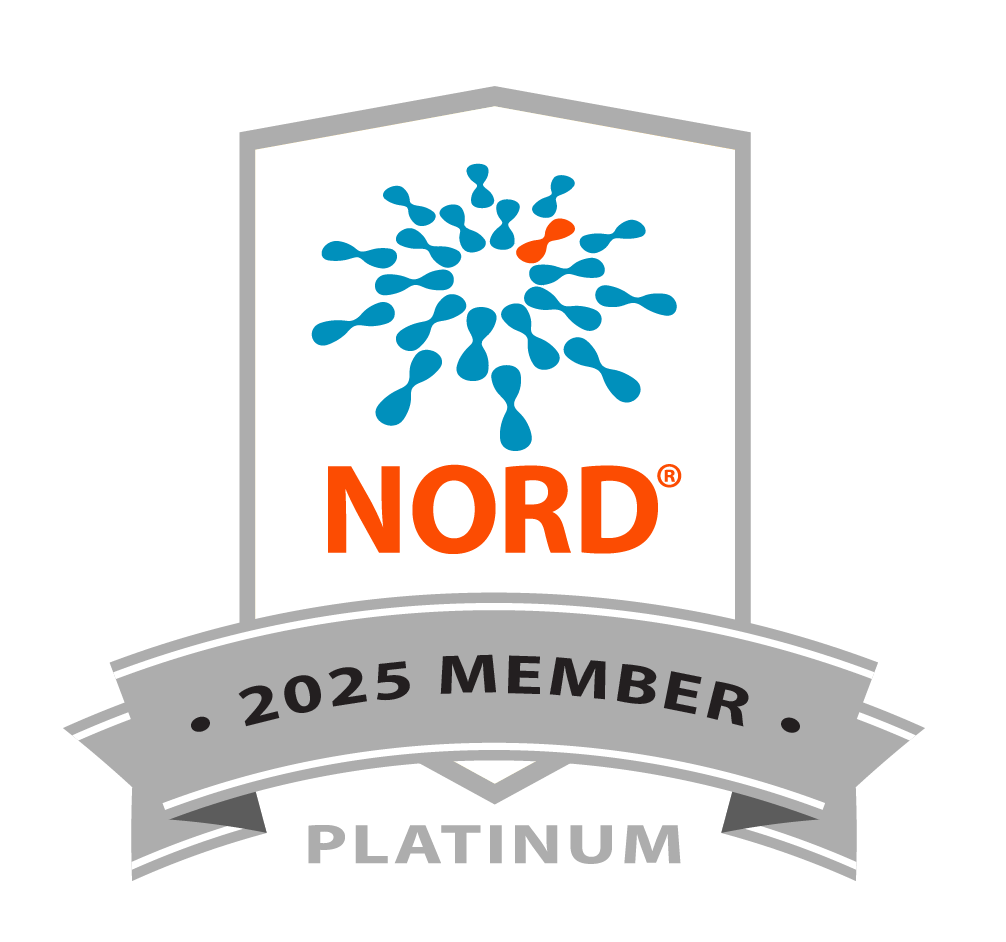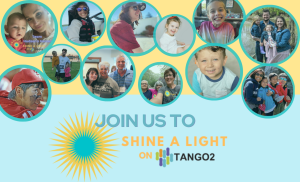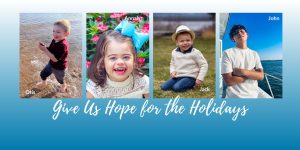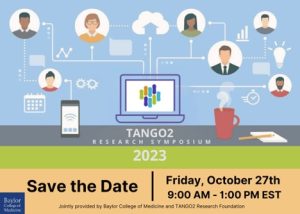STORIES
Click Any Image to View Story
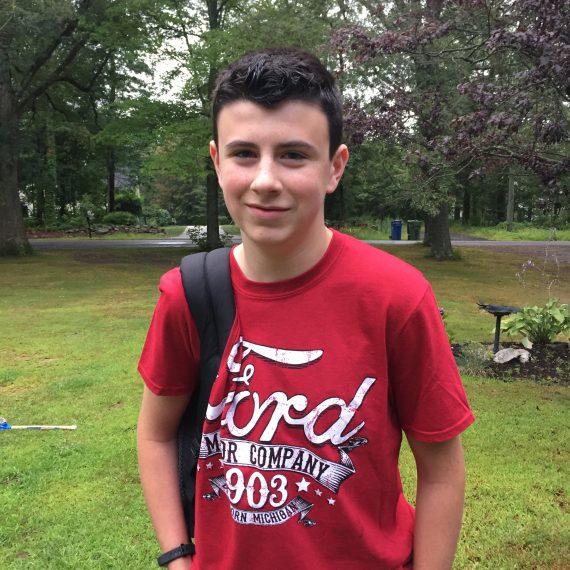
A decade of looking for answers with the best doctors and hospitals in Hartford, New York, Boston and New Haven yielded no results. Everything came back normal - reality of course was quite a bit different. This all changed in June of 2017 when we were told by Dr. Michele Spencer-Manzon, a Geneticist with Yale Children's Hospital, that Ryan had a deletion in the TANGO2 gene on chromosome 22 that had just recently been identified as a gene that contributes to human disease. Finally, a test that didn't come back normal and could begin to explain Ryan's struggles.
Having a diagnosis after all these years came with mixed emotions. Objectively, we knew knowing was better than not knowing. But, what we were learning about it was very scary - TANGO2 disease is characterized by rhabdomyolysis, metabolic crises, life-threatening cardiac arrhythmia and neurodegeneration. Many of the children involved in the initial studies that identified TANGO2 as a gene related to human disease had expressed symptoms much worse than Ryan and several had died. There is not enough information available to know what the long-term prognosis is. What did this mean for Ryan? What did this mean for us as a family?
In mid-November 2017, while still wrestling with the gravity of Ryan's diagnosis and being asked to make medical decisions that would have long lasting impacts on his well-being, we were so very fortunate to find a support group on Facebook where a small (but growing) group of parents had found one another and started to connect and share their stories. It was started by Veronica Jones, a TANGO2 parent from California. We were warmly welcomed into that community and it immediately gave us the sense we were not alone on this journey.
What become very clear as we engaged with this community and learned of their experiences with their children and the medical community, is that not nearly enough is known about how it is that TANGO2 mutations affect our children at the most basic cellular, metabolic and biochemical level. The talented and caring professionals that are working so hard to help our children, lack the benefit of this basic research and are doing the best they can with very limited research and data. That is where the idea for the TANGO2 Research Foundation came from.
Mike & Kasha Morris
East Hampton, CT
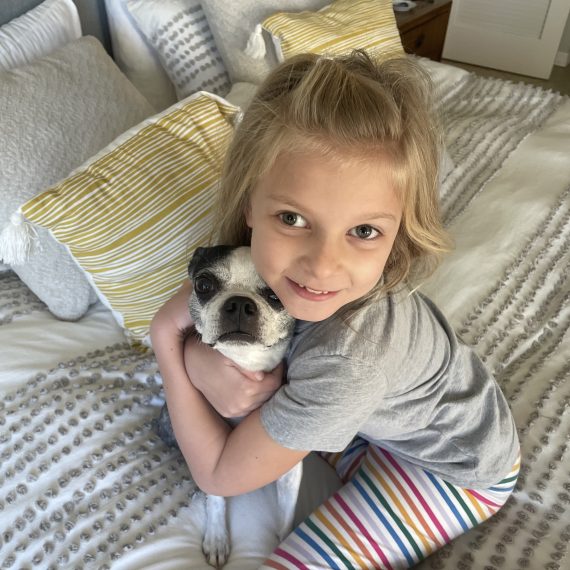
When Thea was 2 years old, we ended up in the hospital after not being able to wake her up one morning. She had been suffering from strange episodes of lethargy and stopped meeting milestones at 18 months old. Finally, after an 11 day hospitalization and a full genome sequencing test, Thea was diagnosed with TANGO2 disease. We learned that the disease was newly discovered, just three months prior to her hospitalization. The doctors did not have much to share about the disease and we had no idea what to do next.
We began to reach out via social media to try to find other families with this diagnosis. Gradually, families around the world began to find us on Facebook and we started to learn from each other. We learned what helped our kids, what made them worse, how to talk to doctors, and eventually how to start a research foundation. 100 families later, we are gaining momentum with the TANGO2 Research Foundation and five promising research projects underway.
Because of this disease, Thea is at risk for mental and physical decline and even premature death. Our greatest fear is that someday Thea won't be Thea anymore. The support of our family and friends gives us hope for a better future for Thea and kids from around that world that have become part of our TANGO2 family.

I want to tell Sammy's story but I want to start at the end somewhat. Sammy finished his journey with TANGO2 disease on October 23, 2018. However, I want to tell you not what the disease did to him but what he did living with TANGO2 disease. From the moment Sammy took his first steps he would stumble and fall. But he would also always get up and try again over and over again. Honestly, this is the story of his life; falling and getting back up! When he was told he couldn't play football because his doctor couldn't clear him to play a contact sport, he cried and was upset! But he quickly found that smile and became the next best thing, he became the "water-boy" as he would refer to himself in Junior High and later the football manager in High School. He became the best player on the team without setting a foot on the field. Sammy was also involved in Boy Scouts of America. He started as a Tiger Cub at the age 5 and completed the program at the age of 17 as an Eagle Scout. The highest rank he could achieve as a Boy Scout! Was it easy? No, it was definitely not but he didn’t give up! His dad was with him every step of the way and he had the most supportive leaders. When it came time to start college he got involved with the basketball team as their manager, a position that wasn’t even available, but Sammy won over the head coach. He was only with them for a month and a half at the time of his death, but you wouldn’t know it by the love his new teammates had for him! He did all this throughout his life undergoing numerous test and hospitalizations as TANGO2 disease had not been discovered. He was the patient that inspired the discovery of the disease. Sammy never let TANGO2 disease define him! He always found a way to live life to its fullest and we, as his parents, allowed him to try anything he put his mind to!
We have no regrets and only an unending gratitude that we were allowed to be his parents and that he is being used to one day find a cure for all of his TANGO2 disease brothers and sisters! Sammy’s TANGO2 disease journey started on June 9, 2000 but it didn’t end with his passing! He continues to be an inspiration to our TANGO2 community, his friends and especially his family! #livelikesammy
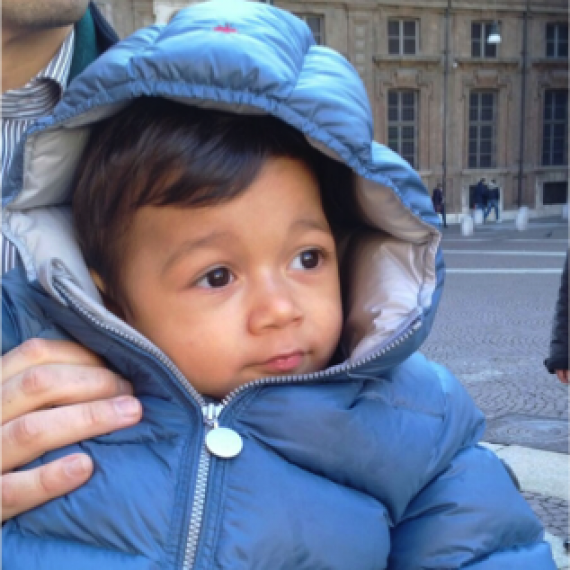
Since he was 9 months old, he started showing some delays in acquiring cognitive and motor milestones. Nevertheless, he was sociable and interacted with those around him.
The first rhabdomyolysis attack occurred when he was 13 months old: very high CK levels, severe hypoanatremia and cardiac complications. We spent 3 months in the hospital undertaking all sorts of tests, without being able to find a diagnosis. We returned home hoping that this was just a one-time episode and that Edoardo would recover soon.
Back home, Edoardo slowly regained muscle tone: started crawling at 18 months, holding himself upright by clutching at a frontal support at 21 months and moving laterally at 24 months. He was producing a few sounds, without real lallation. He did not imitate adults and played in a repetitive way, without significant evolution in its complexity.
At the age of 27 months, Edoardo had a 2nd episode of rhabdomyolysis (one year after the first one). This attack resembled the first one and it was treated in the same way. After 4 weeks of hospitalization, CK levels were back to normal, but he developed a viral infection: CK raised again and the heart was severely affected and experienced a cardiogenic shock (with cardiac arrest). He was in intensive care for two weeks under heavy drug treatment. A nasogastric tube was placed for feeding. Several weeks after heart failure, he slowly started to move again and regained some strength. Recovering from the second attack was extremely difficult for Edoardo and took him nearly 6 months to get back to where he was before the attack.
Thanks to exome sequencing, we finally put a name to his disease. This was both a shock and a relief: at least we now knew what he had and we could do our best to prevent new crises.
Now, January 2018, Edoardo has progressed in both motor and cognitive aspects. He crawls, stands up and moves some steps with limited support. He does understand basic questions and replies non verbally to them. He is always happy and loves being with family and is curious about new people and things.
After all we've been through, we consider every day he is with us an invaluable gift. When he smiles he makes us forget all difficulties we faced and still have to face in the future.
We are glad we found other Tango 2 families with whom to share our experiences, joys and concerns. We are confident that together we will be able to find a cure for our children!

Bria is such a fun-loving, happy girl. She loves animals and has three dogs and two cats. Bria also loves riding horses and making them splash through big puddles. Bria's laugh lights up every room she is in. She is the little sister of an amazing big brother Braxton. Bria is very social, loves playing with her friends and going to school. She has taught her family to truly enjoy life and I am so grateful to be her mom.
Bria was very young when she experienced her first metabolic crisis at 4 months. She had a very rough first year of life and spent time on life support. Since then, she has made a lot of progress. She is on a cocktail of vitamins, has lots of doctor and therapy appointments and she struggles with speech and mobility, but overall she has good quality of life.
FIRST STORY on Bria
This is Bria. For the longest time, we had no idea what caused Bria's 'episodes', the first of which occurred at the age of 4 months. We had spent the subsequent months/years battling back from that. Bria experienced low blood sugar, high CPK and lactate levels, high Ketone levels, brain damage, enlarged kidneys, prolonged QT, Hypothyroidism, uncontrolled seizures, suffered 2 comas, 15 total days on life support, has had feeding tubes, mounds of medications and lots of long hospital stays in her very short 4 years.
Bria has overcome so much. She still takes thyroid medication, a mito cocktail of supplements and patches one eye every day for strengthening. Bria has cognitive delays. She babbles and has some words but has significant speech delays. Bria walks, but struggles with balance issues and gait abnormalities. Those are the medical pieces of Bria which seem hard to believe when you meet her.
Bria as an individual is much more. She is funny and makes herself and others laugh frequently. She is full of life and has a beautiful way about her, both inside and out. She loves her pets (cat Singe and dog Koda) and her family, especially her brother Braxton and is extremely engaged when meeting new people. She studies those around her and works very hard to overcome her challenges daily. Bria takes therapeutic horse riding lessons and it has helped her to walk and build her confidence. Bria displays an everlasting luster to pursue happiness daily. It is this that motivates us to help her in her journey by participating in this research.

Her favorite people are her brothers -- Denton and Reese -- who both do their best to help her when she needs it and support her in what she does. She loves to watch, "I Love Lucy," and is a fan of old musicals. She takes care of her monkey, "E E" and her baby doll, "Mae Mae". Her Mom, Laura, is her hero and she wants to be like her when she grows up.
FIRST STORY - Eleanor (Ellie)
Eleanor was born and lots of pink was brought into our home. She appeared to be healthy, happy, and typical as she approached 6 months, but being the third child what we were expecting wasn’t happening as time went on. Her unexplained delays, loss of body control episodes, random paroxysmal torticollis and in general hard times to thrive were hard to accept. We began talking to our pediatrician and were told that some children just develop slower than others, but her mother still knew something wasn’t quite right. She didn’t start walking until she was 2 years old.
At 9 months, we started Eleanor with Early Childhood Intervention (ECI), a service offered by the school districts in Texas. She began speech and physical therapy and still was not reaching the milestones that we had observed in her brothers. Her mother had noticed that at times she would go into a sort of trance and her body would almost go numb on one side. We would ask her doctor about it, but there were no explanations. When she was almost 2, we were on a mini vacation in New Mexico when she had an episode that not only us, but her grandparents witnessed. We took her to the emergency room back home and they ran tests on her for epilepsy and stroke. After spending the night in the hospital and having several scans done, nothing was found.
After further discussion with our pediatrician, we were referred to Cook Children’s Hospital where we met with multiple pediatric neurologists and geneticists. More tests were run and still, we knew nothing. We finally were referred to a pediatric neurologist with Cook’s who specialized in movement disorders. We were told that her symptoms resembled benign paroxysmal torticollis, but her speech and mobility delays still could not be explained. We continued to treat symptoms, but we had no explanation for what was going on. We were referred to do a Whole Exome Gene Test, which came back normal as well. It took a while to accept the normal test results and yet be grateful for them at the same time, but she was still beautiful and perfect with a smile that still beamed with love.
A few days before Christmas of 2016, Eleanor started feeling sick but we thought it was just a virus. On Christmas morning, she was to the point she couldn’t even lift her own head, so we loaded up in the car and made the 4-hour drive to Fort Worth to Cook Children’s Emergency Room. We were told that Eleanor had rhabdomyolysis and that her CK levels were so high they couldn’t even get a good count on them. After spending 58 days in the hospital, Eleanor was finally at a point they would release us to go home.
When we were headed back to Fort Worth for a follow-up appointment in April of 2017, we received a phone call from a Fort Worth number. We were told that when Eleanor was in the hospital they wanted her Whole Exome Test looked at again. Dr. Alice Bassinger, a geneticist with Cook’s, was calling to inform us that they had identified a deleted gene sequence known as Tango2 in Eleanor’s test. Dr. Bassinger told us that we could look it up online, but that it was discovered within the past nine months and there were only two papers on it. They worked us in the next morning to meet with Dr. Bassinger and we got further explanation. We were so thankful to finally have a name for what was going on, but at the same time aggravated because there was no data on the subject.
We searched for others with Tango2, but it was so new that we found nothing. One night, after checking often, Laura stumbled on a Facebook group for Tango2 parents. We have learned so much in the short time we have been members, but most importantly, we know we are not alone.
Eleanor is the hardest working, most motivated girl you could imagine. She has sounds and can be sassy, but she is still trying to find her voice. She has sign approximations, sounds, and gestures she uses to communicate. She is currently learning to use an AAC device to have a full language.
We are full of hope for her future. While she can be a bit bossy, she never met a stranger and always wants to know the name of those she comes in contact with. She is a caring person who usually has her purse in her tote. Her days can be hard, but her testimony is strong.
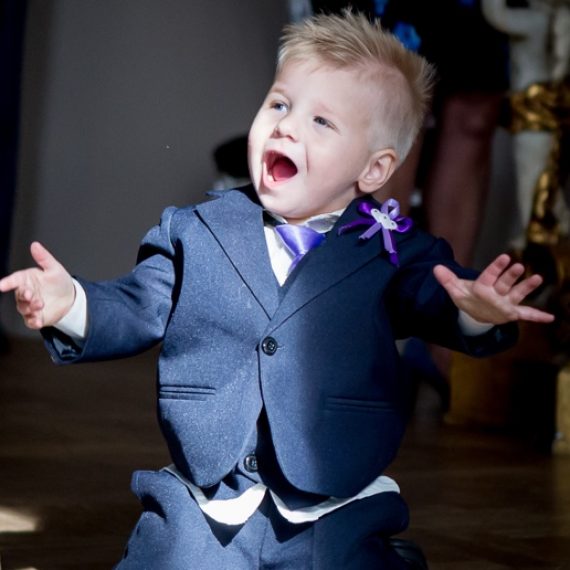
Eventually extensive DNA research was completed, and my husband and I had blood testing done as well. After a long wait we got the results. Liam was diagnosed with Tango2 in April 2017. The blood tests showed that my husband and I are both recessive carriers of this genetic disorder and that it is the reason Liam has this disease.
We were happy with a diagnosis but also very scared because he was the only one in the Netherlands with this rare disorder. We did not know what to expect in the future. Luckily, in December 2017 we came into contact with other parents through Facebook. There we learned so much and realized how nice it was to be in contact with people who experience the same things we do.
Liam has attacks of muscle paralysis with no control over his body. These attacks can last from half an hour to hours. Fortunately these moments are not painful for him. Unfortunately, the attacks of muscle cramps are all over his entire body. Liam begins to shake and becomes stiff. He also has trouble with swallowing and breathing. We have had to call the ambulance several times to have him checked. So far he has no heart failure or blood sugar problems, but we have to keep a close eye on that. There is a chance that these things will happen which scares us.
Liam goes to a rehabilitation center twice a week where he receives physiotherapy, occupational therapy and speech therapy. It is helpful and he is learning a lot there. In addition, Liam is currently taking a “Mito Cocktail” which is a group of vitamins to help the body improve energy production in the cells. It seems to help him but it does not take away all the attacks.
It would be nice if we could find something through research that would make this condition bearable for all these dear children.
Liam is also a very sweet and cheerful three-year old child. He enjoys life in his own beautiful way. Like any three-year old child, he can be naughty and enterprising. He likes to climb and clamber. Nothing is crazy enough. Liam has a sister of almost 9 years, who he absolutely adores. They love dancing and playing together.
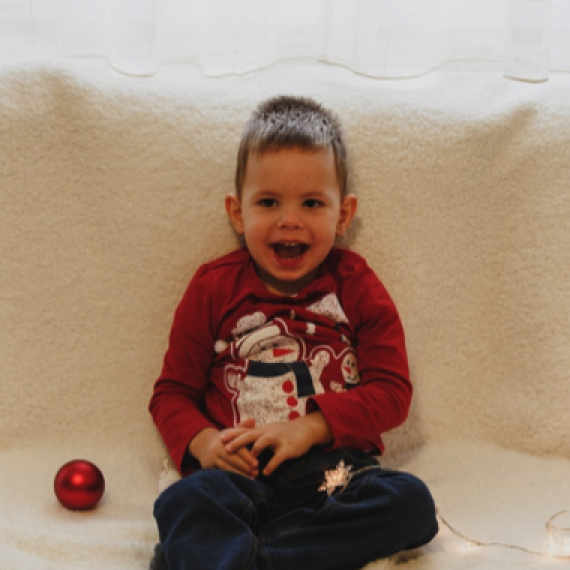
My pregnancy was normal until the 12th week when I started taking Levothyroxine for the duration of the pregnancy. The birth was a caesarean. Matyi’s Apgar score was 9/9, and he cried immediately. His development was normal until he was six months old. At 10 months he still did not crawl or climb. Therefore, we started going to a foundation for conductive gymnastics (both movement and skill development). He rose to his knees at 13 months, started climbing at 14 months and could stand up with help at 18 months. He has been able to do a few steps since then with help, but he does not walk alone. He walks on his toes a lot. He can make speech sounds but he can not pronounce words. He will make his wishes known by pointing and making noises.
The first health symptoms occurred at 20 months of age, when he was not able to move. In December 2016 he had a seizure. That was when he first went to the hospital. I was already pregnant with my little girl. The tests did not show anything. From that point on he had many symptoms: unable to stay standing, leaning in one direction, neck tilts to the front or back. He could not go further than four feet. The had a second epileptic seizure in May 2017.There were several EEGs that showed activity while sleeping. In November 2017 he started medication for epileptic symptoms. But in December 2017 he had 3 weeks that were so bad he could hardly eat and drink. So he stopped taking the drug for epilepsy and started to get better again.
Matyi eats 5x daily (breakfast, snack, lunch, snack, dinner). I'm currently giving him a gluten-free diet because I've found that food absorption is better. His stools were inconsistent. He can chew, but fluids often pour out of his mouth. Typically he drinks very little. When he does not feel well, he can not chew properly.
Matyi is a very kind person. He likes to knock down building blocks, but he does not build with them. He likes to swing and his favorite toy is a rocking horse. It always seems to calm him.
He sleeps well at night (typically 8pm to 6:30am). But he has been sleeping less and less during the day. He can be restless at night sometimes whispering or moving his legs a lot.
Matyi currently receives physiotherapy twice a week. His muscles are very tight, particularly the Achilles tendon. Since January 2018 his eyes cross at times. The doctors have been helpful, but they do not know much about Tango2. Currently, Matyi takes LEVOThyroxine to treat hypothyreosis. He also has a vitamin combination including vitamin D, vitamin C, vitamin B12, and Béres drops (http://www.beres.hu/beres/termekek/beres_csepp) as immune enhancers. Other medical tests are currently in progress, as we just received a diagnosis on February 19, 2018. We are still waiting for results of genetic testing on my little girl.
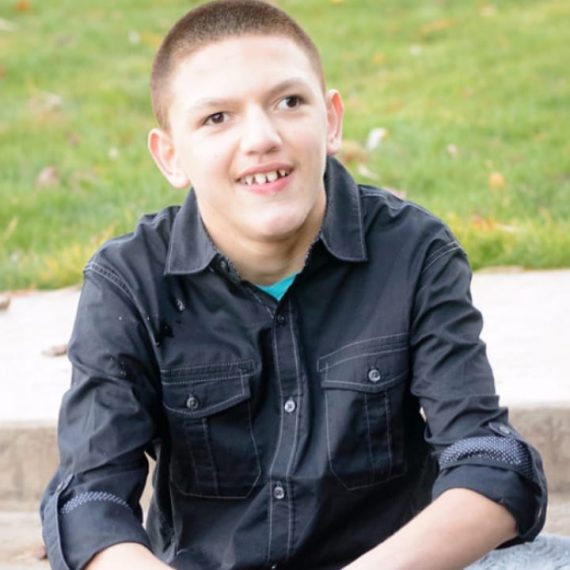
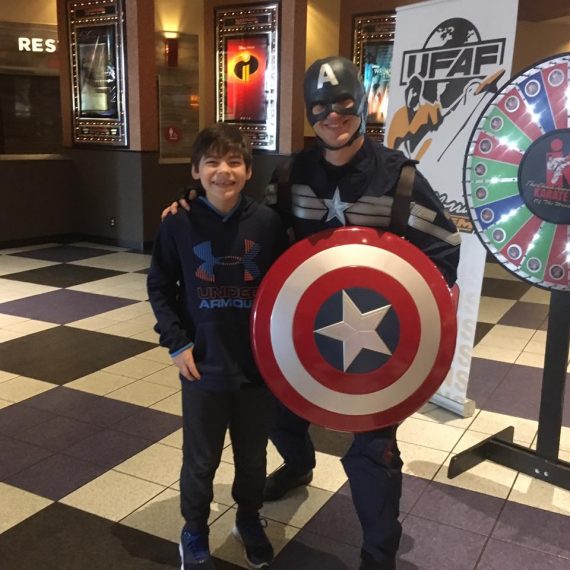
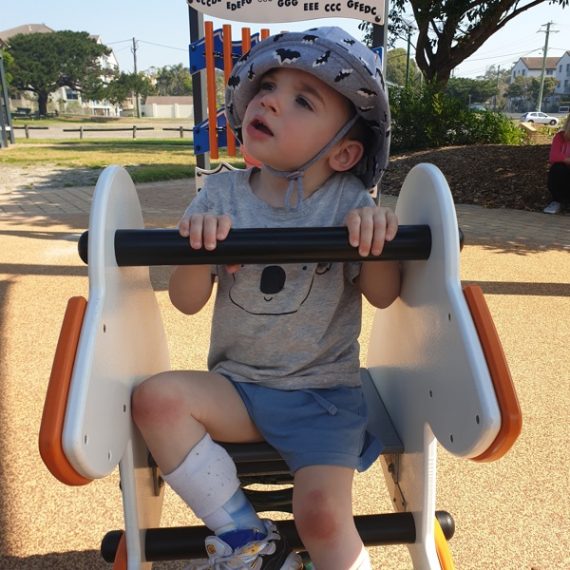
We received the news that Harrison had a micro deletion at 22q.11.21 Tango2 and it inherited from Caitlin and Kyle. It was around the age of 18 months to two years old that Harrison started to have “episodes”, where he would completely lose energy and lay on the floor. These would last anywhere from 30 minutes to two hours and as soon as they were over Harrison was right as rain. Since starting on a “mito-cocktail” Harrison has been episode free for several months.
Harrison has had EEG’s, ECG’s, heart ultrasounds, urine samples, blood sugar pricks and is perfectly healthy. At 2.5 Harrison has not had a metabolic crisis, or any symptoms of heart disease or seizure. We check in annually with all the specialists. Harrison does have grommets (ear tubes) inserted, which has made a difference to the amount of illnesses he picks up. He has as slightly lazy eye.
Harrison wears AFO’s and is diagnosed with both hypertonia and hypertonia. He is learning to walk with a posterior walker, yet has little motivation to get up and move because crawling is so effective for him! He can get wherever he wants to go.
Harrison sees speech (is considered pre-verbal), OT and physio weekly.
Harrison loves cars and trucks, adores baths and swimming pools and the ocean. He is a very happy little boy who loves to spend time with his parents, grandparents and friends. He is very kind and will share all of this belongings with everyone he comes across.
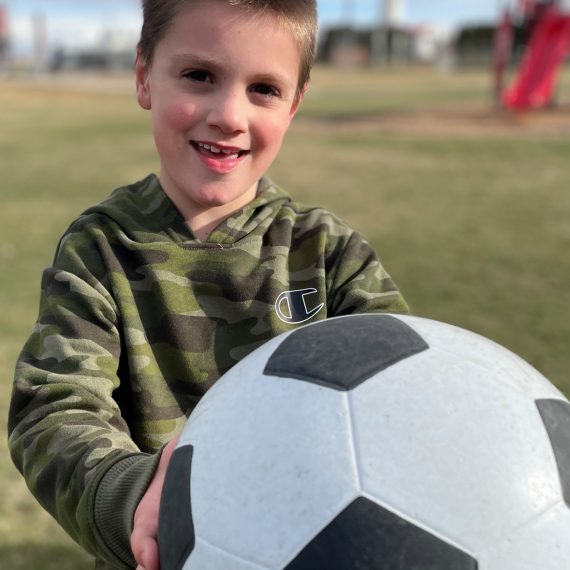
FIRST STORY about Danny
Meet Danny Messerschmidt! He was born on October 29, 2014. He has two siblings also affected by TANGO2 related mitochondrial disease. His older brother Jackson passed away in 2015, and his younger sister McKenna who is almost 2 years old. Danny was diagnosed in September of 2016. There were no complications before, during, or after his birth. He met milestones of rolling over, sitting, and crawling relatively on time. We noticed his head size was tracking small at 6 months of age, and his growth was slowing down but other than this he seemed like a very typical infant. He ate well, slept well, and was very happy.
At 11 months of age, he started having difficulty sleeping and was not eating as well. He had his first seizure shortly after this, a tonic clonic seizure. At this time, development plateaued. His feeding skills regressed, and he really struggled to grow. At age 15 months, he was diagnosed with gastroparesis. He also had swallowing problems. Around this time, we started to see episodes of muscle weakness that had a rapid onset and lasted anywhere from minutes to hours before resolving. Once seizures were controlled well with medication, we started to see development progress again. He began walking at 22 months of age.
At age 2, he received a feeding tube in his stomach, which helped him grow and took pressure off of trying to get him to eat enough and stay hydrated. He experienced significant weakness after anesthesia. It took him two days after surgery before he could bear weight on his legs. He had leg weakness for almost two weeks after surgery but did fully recover. Today, he is two years seizure free and is growing well. He has not required any hospitalizations during illnesses. He attends a special education preschool as well as physical, occupational, and speech therapy for developmental delay and sensory challenges. He loves playing with his little sister and is very social. He loves being the center of attention, and although he has few words, he does a pretty good job of making everyone around him laugh. You can bet he is the class clown at his preschool.
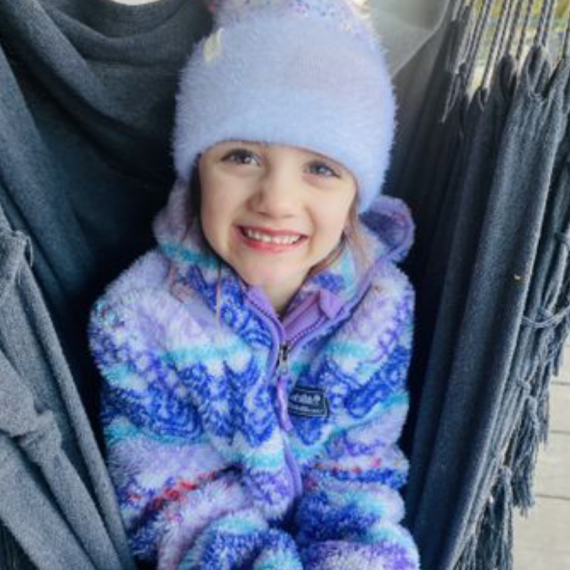
McKenna was diagnosed with TANGO2 disease in 2016 at around 7 months of age, shortly after her two older brothers were diagnosed. She has a feeding tube for most of her nutrition/hydration, although she does eat recreationally as well. She is developmentally delayed in all areas, and although she has never experienced a metabolic crisis, she has struggled with severe epilepsy which thankfully is now managed well with medication. She has thankfully been medically stable and has not had a hospitalization since 2019. As parents of TANGO2 children, we know this will not last forever. We know how unpredictable this disease is, and we know these good times will not last forever. Tomorrow is not promised with TANGO2 disease. We don't know how her disease will progress, or when it will happen. We do know that we will cherish the good times, always focus on her quality of life, and continue to advocate for her always. We are so thankful for the TANGO2 research foundation funding research in to this disease so we can one day treat this disease!
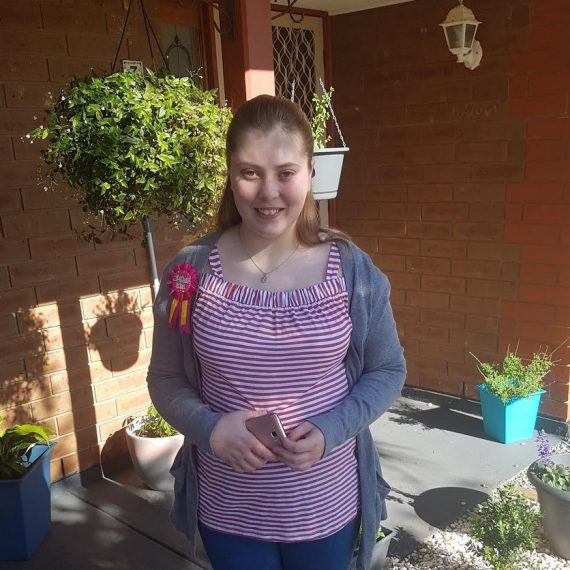
Then, she had a bad enough episode for doctors to finally see and we got the diagnosis of episodic appendicular dystonia. This has presented differently and infrequently over the years. As Brianna grew older, it became more noticeable that she had global developmental delay with moderate intellectual delay. We started early intervention therapy.
She started school in a special needs unit within a main stream school. Brianna absolutely loves school. She is a caring, friendly and well loved member of her class. She is very routined with school and doesn't like to have to stay home if she sick or have a student free day - she just loves to be at school.
Everything seemed to be okay with the exception of a few bad days with her dystonia and some slurred speech - especially when tired. Then, on January 15th 2018, she couldn't walk at all and was so tired (and sleeping constantly) that I rushed her to Adelaides WCH. After a few hours of tests, her neurologists was desperately trying to figure out what was going on with her. They finally got a urine sample from her and it was black....it shocked me, I had never seen anything like it.
She had Rhabdomyolysis. We could not understand why this had happened to her as she didn't fit the most common causes.... her CK levels were 250,000. IV therapy was started straight away and it was a battle to stop her kidney and liver from failing. For 9 days that battle continued to flush this toxin from her body.
Then on the 10th day, at 4:34 am, heart was suffering severe tachyarrhythmias and she went into complete cardiac failure. The MET team from the Royal Adelaide Hosptial came over to place her on ECMO and transfer her to the RAH intensive care unit were she stayed for another 9 days before the Royal flying doctors transferred her to Melbourne's Royal Children's hospital and specialist cardiac hosptial there. She remained on the ECMO machine for another 8 days We waited and prayed every day that her heart would recover enough to start beating again - the doctors were talking about heart transplants and portable heart machines which was alot to take in. Then a miracle came - her started beating again strong enough to come off ECMO. Then after another week, we could start to bring her out of the coma .
Her body was so deconditioned by everything that had happened to her she had weeks and weeks of rehab ahead of her. We were transferred back to Adelaide and 13 weeks later, we are finally home. Brianna has come along way in this time and we still have a journey ahead with physiotherapy etc.
So, this episode that's turned our lives upside down is how we discovered the diagnosis of Tango2. We're so grateful to know what is going on with Bree, but as we all know, there is much more to learn about this gene and its mutation. Brianna is the sweetest, most genuine caring young lady (slightly biased) and I hope her story helps this important cause and research.
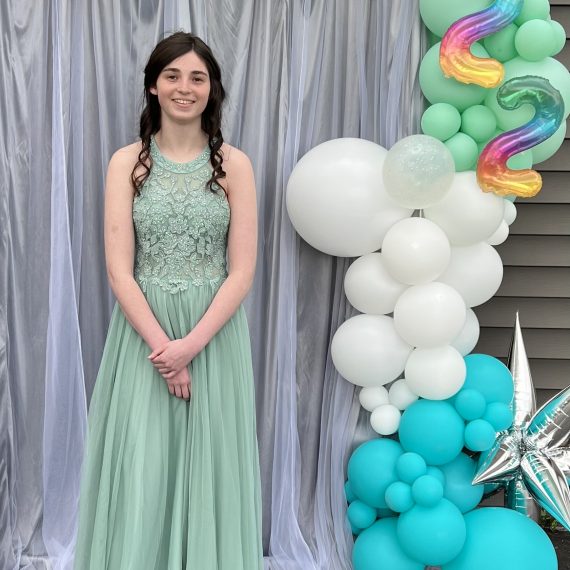
FIRST STORY about Katie.
Meet our daughter Katie. When you look at Katie you see a typical 14 year old girl, and in some ways she is. She loves music, watching YouTube videos, swimming and just hanging out with family and friends just like other kids her age, but Katie isn’t like every other kid her age. She struggles with something that very few of us have heard of, know much about, or can do anything about.
About a year ago we received a call from one of the many physicians we had seen over the years and we were told that we have a diagnosis. They had our blood on file and were able to link us to others with similar symptoms and the same genetic abnormality. Katie had a diagnosis of Tango2. For years we had been searching and hoping for a medical diagnosis and now we have one. The only problem is that there isn’t much known about Tango2. There is no cure, there isn’t any treatment or pill to take that will make things better for her.
When Katie was about 3 we really started to notice that something was off. Looking back it probably started a year earlier, but wasn’t obvious to us as parents. We thought the stumbling around was because she was tired, her lack of memory was because she wasn’t paying attention. The symptoms that made us call the doctor where that Katie wasn’t able to walk a straight line and her head was tilted to the 10 o’clock position. Off to the ER we went, and after a couple days stay, and all kinds of tests including a spinal tap, CT, MRI, EEG, they sent us home with no answers and all test results were normal. Over the next several years she would have many similar episodes… trouble walking, trouble speaking, trouble sitting up and sometimes trouble with using her hands… each time just a little different. We had visited many doctors but no one could tell us what was happening, why it was happening or treat the symptoms.
In 2013 Katie became very sick; we thought she had the flu, but it ended up being much worse than that. In the middle of the night we ended up in an ambulance on our way to the hospital. Katie was admitted to the PICU and was unconscious for about 2 days, and no one knew why. We weren’t sure if she would ever wake up and if she did we weren’t sure how she would be. We were lucky Katie made it through, some kids have not been so lucky. We started over trying to find a diagnosis. We were off to see new physicians in multiple states with high hopes. We ended up having genetic testing done, still no answers. The doctors kept her sample on file which ultimately led the clinicians to connecting her to others with the same deletion in the Tango2 gene.
We still don’t really know what this diagnosis means for us and for Katie, but we now know we are not alone and find hope in that. Katie will always struggle developmentally and cognitively, but now that we have this diagnosis perhaps we can better protect her from having another metabolic episode and if it does happen again we will at least be better informed and prepared to treat her.
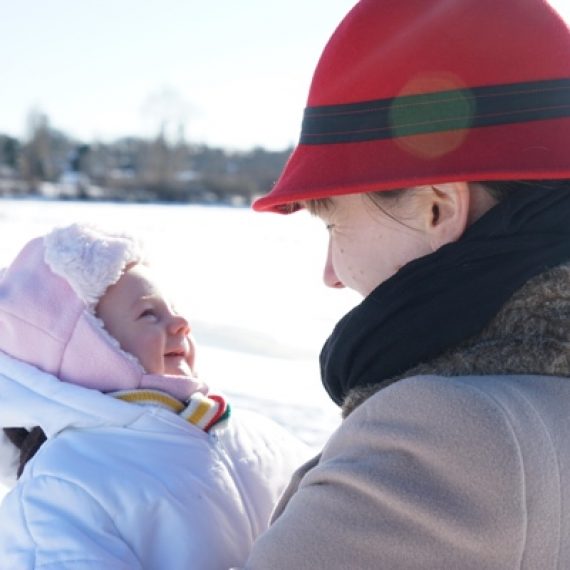
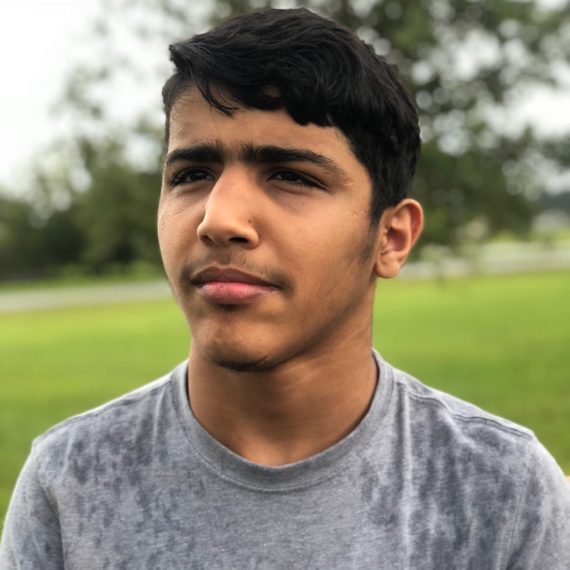
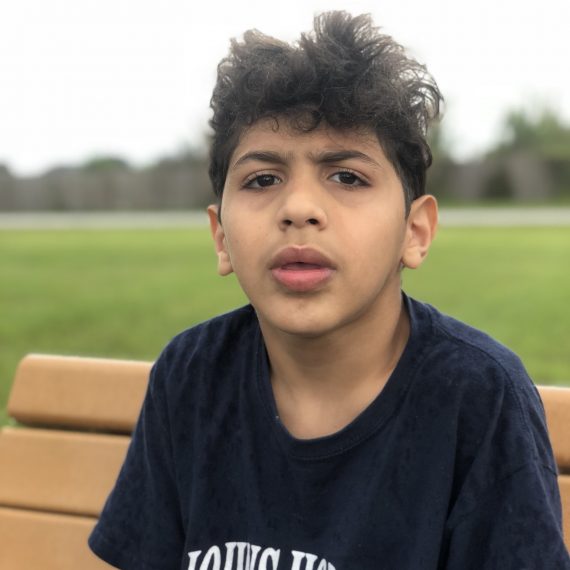
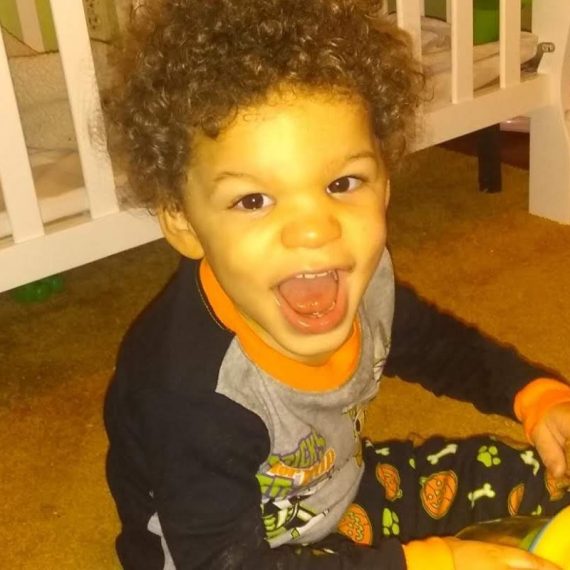
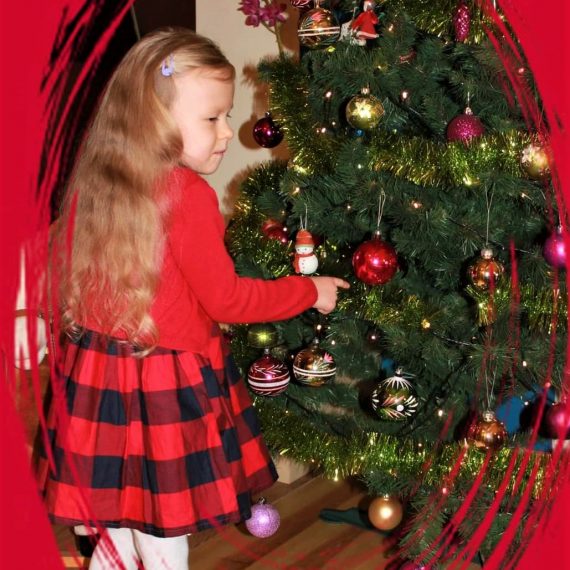
Milena was born on the 19th of September 2014 in the south of Poland. On the first day of her life everything was fine, but after few days she was diagnosed with VSD and ASD heart defects. The medications she was taking for her heart did not help her and when she was 5 months old, she had open-heart surgery. She was doing pretty well after that, but the surgeon told us she might have a Syndrome (22q11.2 deletion) as she has no thymus which the doctors noticed during the surgery. When she was about 4 years old, we decided to take a genetic test which only confirmed DiGeorge Syndrome.
Long before that diagnosis Milena started to have a speech and physiotherapy because she had some difficulties in saying first words and walking as well. She started to walk at the age of 3. Despite we had the diagnosis of DiGeorge Syndrome we somehow knew that something more was wrong because she was having the episodes of weakness which no doctor could explain or even understand. Those episodes started when Milena was about 16 months old. Most of the time she was doing fine, was cheerful and happy, but from time to time she would become extremely fatigued, she could not say a single word, sit straight, grasp toys, or even eat or drink. It usually lasted for about 2 hours and she would wake up in the morning. Sometimes it happened once a week, sometimes more or less often, but almost always after a fever. No doctor could tell us what makes her so weak and sleepy because all the blood tests, including the glucose level, were always normal.
The turning point came in February 2020 when Milena fell sick with a severe viral infection (probably Covid 19, but there were no tests for Covid at that time in Poland). The infection included pneumonia and a very high fever which lasted for about 6 days. She would take antibiotics and after few days everything seemed to get back to normal, but our little princess was weaker and weaker, she did not want to eat or drink much so we took her to the hospital and the blood tests just shocked the doctors! Her CK was at the level of 160,000 and she had very high levels of transaminases as well. After two days in the hospital she fell asleep and woke up only after 4 days in Intensive Care where she spent 7 days altogether. It was her first metabolic crisis. She was lying down in bed not moving a single finger during the first days after she woke up, but during the following weeks she regained all her abilities and skills that she had before the crisis. Thank God, even though she had heart surgery (or maybe thanks to it?), she had no cardiac complications during or after the crisis. She fought a harsh battle and she won it.
Our doctors started to look for the reason for the crisis and one of the doctors told us about TANGO2. After about a year we got an official diagnosis. It was May 2021. Our geneticist told us that Milena is the only one in Poland who has been diagnosed with TANGO2 so far. We got some crucial pieces of information on what can cause her crises and how to react if one happens in the future, which is basically eliminating proteins from her diet and giving 10% glucose (about 2 liters per 24 hours). Despite all the information we had about TANGO2, we could not save her from having the second crisis which came in November 2021, almost two years after the first one. However because we now knew how to react during the crisis, the second one was much lighter than the first one and Milena was doing pretty fine, leaving the hospital after about 3 weeks.
In February we decided that Milena should have a PEG tube because after few years of a constant struggle to make her eat and drink more, we now know that she was not sufficiently meeting her needs. Through the PEG, she will mostly get hydration and nutrition because she is not able to eat and drink much -- especially during the episodes of weakness. We would like to start giving Milena a mito-coctail which we hope will help her to stay in a good condition and keep her smile on her beautiful face forever!
We are more than thankful for the TANGO2 Foundation for your research and huge support of our unique children and their families!

Annie met all milestones until around 12 months, a bit of a “late bloomer” but she always got there in her own sweet time. She hit a bit of a development plateau from around 14 months. Around the same time her weight started to decline slowly, and she did look pale often, but all health professionals I asked said to monitor her but not be worried.
I can see now that she started to have episodes of muscle weakness and severe fatigue around 16 months old. She would be sitting independently and then slump forward unable to support her torso or head. Then after a period of rest (and sometimes a feed) she would bounce back and to be honest I often wondered if I had imagined it.
She had her first metabolic crisis on Christmas Day 2020 aged 18 months. After a bout of vomiting (we still don’t know what from) she was unresponsive, and paramedics rushed us to Emergency at Royal Darwin Hospital. Her blood sugar was dangerously low, neurologically she was very vague and physically she had low muscle tone and was leaning to her right side. What saved her that day was that the paramedic that attended put an IV line in and started giving her glucose and fluids. After a couple of weeks in hospital, endless tests, EEG’s and an MRI we left hospital with no real answers but a little girl who was recovering well.
In March 2021 following her meningococcal vaccine and associated fevers she had another episode of severe ataxia, vagueness and loss of muscle tone. After repeat EEG (some seizure activity shown) and MRI (all clear) we were started on anti-seizure medication and diagnosed with Epilepsy.
Adjustment to the anti-seizure medication (carbamazepine) was rough. Annie was very drowsy all the time. We battled it for 2 months, just finding some level of normalcy when the dosage would be upped, and we would start all over again. She continued to have seizures and periods of muscle weakness during this time.
In June 2021, just before her second birthday she got gastro and after 14 hours of vomiting and not tolerating any fluids we took her to ED. She continued to decline in the days after our admission. With no answers to the ever-increasing questions, the doctors cast the net wide with their testing and discovered elevated CK levels, low thyroid levels, low blood sugars, a prolonged QTC (heart arrhythmia), severe ataxia and a declining neurological state. Her CK levels peaked at 275,000 and her heart and kidneys were just holding on. So were we. Those dark days of feeling our little girl slipping through our fingers as we held her and not knowing what to do were the hardest days of our lives.
There was no pediatric ICU facility where we were and she was too unstable to transport so we bunkered down and prayed for a miracle and minute by minute, hour by hour, day by day, week by week we got one. After bouncing in and out of hospital for 4.5 months Annie turned a corner and stabilized.
Annie has now been seizure free since October 2021 (now on Keppra) and up until last week hadn’t had an episode or hospital admission. We have moved to be closer to the Royal Children’s Hospital in Melbourne to better support her and her condition. She has an NG (nasal gastric tube) and we are awaiting surgery for a PEG.
Annie has some speech and developmental delays, is still a little unstable on her feet but she is here, and she is amazing. Just like all of our TANGO2 warriors, they are the definition of courage, of joy and of hope.
FIRST STORY about Katie.
Meet our daughter Katie. When you look at Katie you see a typical 14 year old girl, and in some ways she is. She loves music, watching YouTube videos, swimming and just hanging out with family and friends just like other kids her age, but Katie isn’t like every other kid her age. She struggles with something that very few of us have heard of, know much about, or can do anything about.
About a year ago we received a call from one of the many physicians we had seen over the years and we were told that we have a diagnosis. They had our blood on file and were able to link us to others with similar symptoms and the same genetic abnormality. Katie had a diagnosis of Tango2. For years we had been searching and hoping for a medical diagnosis and now we have one. The only problem is that there isn’t much known about Tango2. There is no cure, there isn’t any treatment or pill to take that will make things better for her.
When Katie was about 3 we really started to notice that something was off. Looking back it probably started a year earlier, but wasn’t obvious to us as parents. We thought the stumbling around was because she was tired, her lack of memory was because she wasn’t paying attention. The symptoms that made us call the doctor where that Katie wasn’t able to walk a straight line and her head was tilted to the 10 o’clock position. Off to the ER we went, and after a couple days stay, and all kinds of tests including a spinal tap, CT, MRI, EEG, they sent us home with no answers and all test results were normal. Over the next several years she would have many similar episodes… trouble walking, trouble speaking, trouble sitting up and sometimes trouble with using her hands… each time just a little different. We had visited many doctors but no one could tell us what was happening, why it was happening or treat the symptoms.
In 2013 Katie became very sick; we thought she had the flu, but it ended up being much worse than that. In the middle of the night we ended up in an ambulance on our way to the hospital. Katie was admitted to the PICU and was unconscious for about 2 days, and no one knew why. We weren’t sure if she would ever wake up and if she did we weren’t sure how she would be. We were lucky Katie made it through, some kids have not been so lucky. We started over trying to find a diagnosis. We were off to see new physicians in multiple states with high hopes. We ended up having genetic testing done, still no answers. The doctors kept her sample on file which ultimately led the clinicians to connecting her to others with the same deletion in the Tango2 gene.
We still don’t really know what this diagnosis means for us and for Katie, but we now know we are not alone and find hope in that. Katie will always struggle developmentally and cognitively, but now that we have this diagnosis perhaps we can better protect her from having another metabolic episode and if it does happen again we will at least be better informed and prepared to treat her.
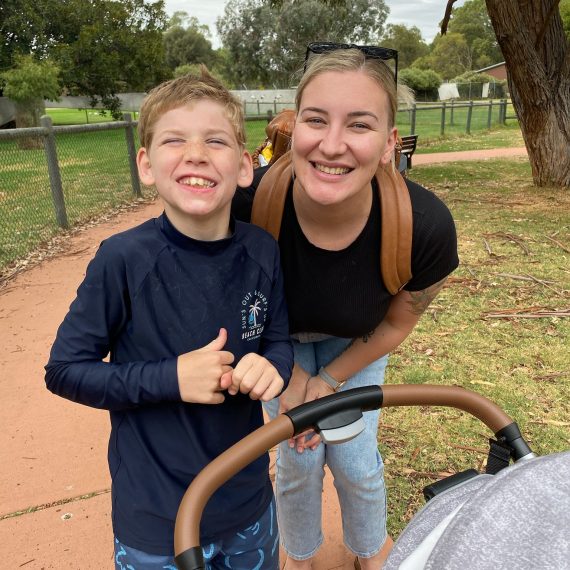
He struggled with signs and symptoms for 5 years before a diagnosis. (2013-2018). These symptoms can be seen as excessive drooling, severe fatigue, slurred speech and decreased mobility and motor skills. Diagnosis was in 2018 after a fluke running of tests. Our paediatrician wanted to "just see what came up" and TANGO2 did.
A handful of hospitalizations and nearly losing him to TANGO2 complications (i.e. early stages of heart failure, CK levels of 350,000 and being resuscitated twice in one day) in 2019 made us hold him tighter than before and believe bigger thoughts of hope. He fought, and he fought, and he survived something huge.
The biggest issues we have are honestly living the unknown with cardiac complications, rhabdomyolysis and CK levels hovering over us from the past.
Regular check ups help with that though - we see a neurologist, metabolic specialist and cardiologist every 3-6 months as well as a dietician. His mito cocktail makes up a big part of Daniel's success and recovery from 2019 - since then, he was required to also have a PEG tube put in place to assist with his nutritional intake. We wouldn't be where we are now without them and the current studies we have on the disease.
Daniel, in my eyes, and many of our family members, is a true miracle and always will be.
Our journey is complicated and long, yet it is worth knowing about. This is just a snippet into our life and our past.
But our present and our future are so bright as we still have Daniel with us and he is as healthy as he has ever been. He is thriving, he's in school getting an education and he is loved. He loves his life and seeing him so grateful makes it easier living with TANGO2.
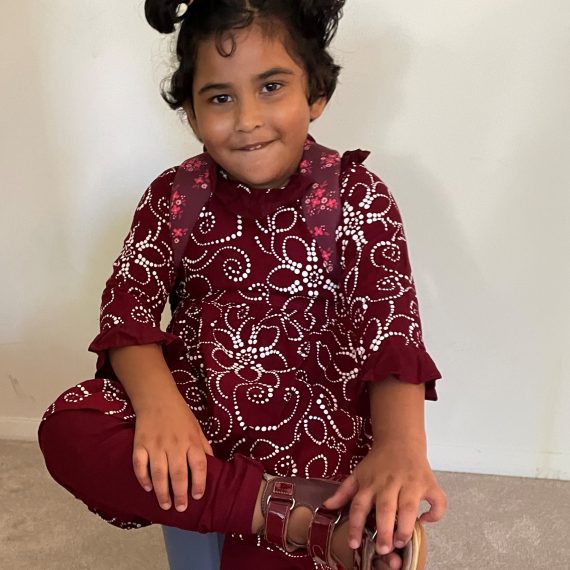
Her personality is very friendly. She likes to share her toys with everyone but her little sister. She always wants her sister to be around her, but no sharing.
Nusaiba was born 18 days early. She was born underweight -- only 4 pounds 11 ounces.
She was late at reaching her milestones from the beginning. She was able to sit up properly after she was 9 months old. She couldn't walk until she was 18 months old. Her first words came after she was 1 year old. We didn't really worry too much because family and friends kept on saying every child is different and some just are slow in the beginning but will eventually catch up.
After her second birthday, Nusaiba started to tip toe and started having gait issues. She started PT and when she was 3 we gave her Botox and AFOs. Her walking was getting worse and worse. We repeated the Botox and did serial casting. She did walk for a month or two, but then started to lose balance and began to crawl. She just crawls now at home and sometimes uses a gait trainer at school. She is extremely spastic on her both legs.
Her few words that she had were also disappearing after her second birthday. She had an MRI, lot of genetic testing, but no result tied to her actual disease.
She also had her first episode when she was 26 months old -- only for a few minutes. We had no clue what was going on. We put her to rest, and she woke up normal. Then she started to have her episodes of drowsiness every six months and gradually it started to happen every day where she cannot open her fists, she keeps on stretching her body, she loses control of her head and cries. These episodes only occur to Nusaiba between 11am and 2pm. So far, I have never seen it happen in the evening.
At around age 3.5 years, doctors gave the diagnosis of Cerebral Palsy. No doctor could figure out what was happening and why Nusaiba was regressing. She has been taken to so many doctors. After revisiting the genetics team when she was 4.5 years old, we were offered to have the exome test done and a few weeks later, a genetic counselor called with the results and diagnosis of all her issues --TANGO2.
She has never had seizure or metabolic crisis until her 5th birthday on January 29th of this year (2022). Our poor girl had to be in the hospital on her birthday due to her first seizure in life. She was unresponsive for almost 19 hours.
It has been challenging to raise her. It’s very challenging when a person is both physically and mentally hit hard. Being nonverbal makes it even harder. Every day is a test for me and my family now. Her smile does help to wipe out the pain that we have to go through.
I pray and I hope there will be a cure out there soon where my daughter will be back on her feet and will not have any of the pain that she and other TANGO2 patients are going through. I’m hoping for that miracle to come for us.
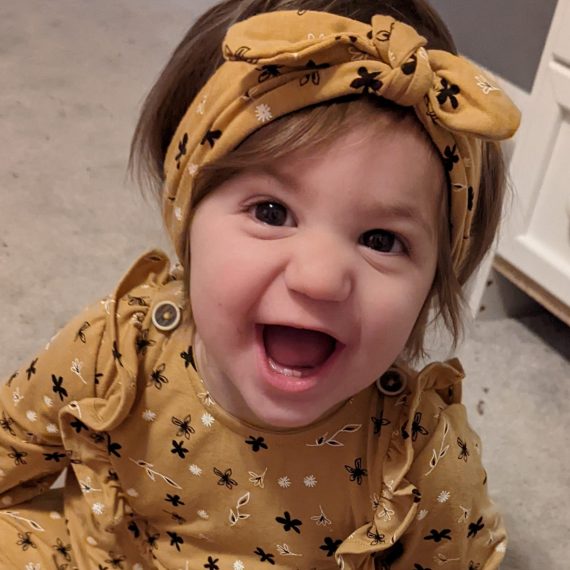
The diagnosis of TANGO2 for Aislynn came two weeks after she was admitted to Cincinnati Children's hospital. Up until this point, she has developed normally. She met all milestones besides not walking yet. But our pediatrician wasn't concerned with how she was growing. I was actually in the hospital with my other daughter Adelaide who was being treated for Kawasaki disease when my husband calls me and tells me that Aislynn won't wake up from her nap. After rushing her to the emergency room and being transferred to the children's hospital, and so many tests, our genome sequencing results revealed her diagnosis of TANGO2. With her being unresponsive and her blood sugar dropping so low, she has a lot of brain damage. We're not sure what her recovery will look like yet. We are still in the ICU.
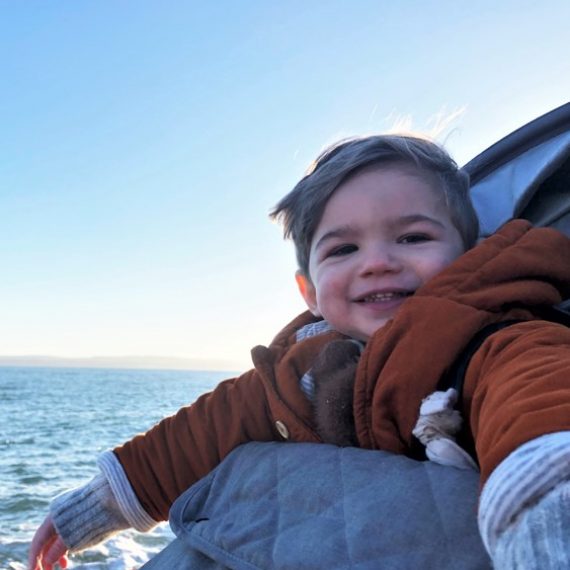
Otis is 2 years old now and has grown to be a wonderful little boy with a smile that can melt your heart into a puddle of joy. We are in awe of his loving, gentle and kind nature, his playfulness and tight cuddles. Otis hasn’t had many opportunities to play with other children but he will be sure to capture the attention of adults and flirt relentlessly with nurses and consultants regardless of the distress of having a cannula inserted. He is so brave and forgiving.
Otis has a love of music and the sea. He will happily strum his ukulele and sing or make a dash for the water at any opportunity. He loves nothing more than to make people smile, Otis has so much happiness to share.
When Otis was 13 months old he had his 1 year immunization jabs and a visit from the Health Visitor for his 1 year review. She was happy with his development and we discussed his night feeding. She explained that night feeds were no longer necessary and that to continue was more for my comfort than for his benefit. We took her advice and my partner settled Otis when he woke for his feed instead.
The following morning our lives changed forever. Our little boy woke as normal and I brought him to our room for a feed as I would usually do. Although this time he didn’t take his feed and went back to sleep in my arms briefly. I assumed he may have been more tired than usual due to the change in our routine. When he stirred I took Otis to his room to change his nappy and clothes. On the way he let out a groan and vomited green bile-like liquid down my arm. Otis was never a sick baby so this immediately caused concern. I lay him back down and he became unresponsive. We rushed him to the hospital.
Upon arrival Otis was taken out of my arms and taken away through the Emergency Department to the resuscitation room. Before we could follow we were warned that there would be a lot of people with Otis and it might be a shock. Going into that room was like a gust of frenzy. There must have been 10 or more medical staff from different departments all frantically trying to revive our little boy. He would not wake up. Tubes, monitors, leads, everywhere. It was like being in the middle of a film set except there wasn’t a director calling cut. We wanted this to stop, it didn’t feel real but the scene just kept playing. It was horrific.
No one could explain what was happening or why it was happening. The more questions we asked, the darker the answers we received. I asked if he would wake up and if he might die. The response we received was not what we wanted to hear. I stopped asking questions after that because everything was out of my control. We needed to keep strong and pray for Otis to be ok.
It was explained to us that it looked as though Otis was experiencing metabolic acidosis and they administered bicarbonate to try to balance it out. At this point Otis was scoring 7 on the Glasgow Coma Scale. Coma. Our little boy was in a coma. It was decided that he needed to be intubated to keep him stable and transfer him to the nearest specialist children’s hospital which was an hour and 45 minutes away. Otis was taken by ambulance and we followed behind by car. I don’t know how Simon managed to drive us there. We were both so scared that Otis might not make the journey. When we arrived at the Paediatric Intensive Care Unit (PICU) we were given an opportunity to hold Otis’ hand while he lay quietly being monitored with leads connected from head to toe. He was so still, I recall quietly feeling for, hoping for any slight twinge in movement from his fingertips to mine, any indication that Otis was still with us. Hope was all we had, it was everything we had.
The following morning after staying at the hospital, I went to see our little boy. Due to Covid the PICU ward had a one-parent policy for visits. I was met by a nurse who told me Otis had caused quite the scene by removing the intubation himself. He was awake!! Flooded with relief I held our little boy so close but delicately as he was wrapped in a variety of cables. We are so grateful he woke up. Our fears didn’t end there -- what we didn’t know was that they were just beginning.
We spent two weeks in the hospital while Otis was being monitored, tested and given time to recover. The metabolic team had given Otis the diagnosis of VLCAAD, a condition where very long chain fats cannot be processed by the body. After NG tube feeding training and guidance on how to manage and treat this condition we were sent home together and started to get our heads around adjustments we were to make together as a family.
Simon received a call 3 months later from our metabolic consultant. She explained that following blood results Otis does not have VLCAAD but will need further testing from the genetics team to establish what it could be. We were back to square one with no idea what we are facing. Full exome sequencing testing took place and another 4-week wait to find out what we were up against. “Hope for the best, expect the worst” we were told.
June 9th 2021 we met with our metabolic team and genetic counsellors who explained to us that Otis has been diagnosed with TANGO2. We had no idea during the meeting if this was the best news or worst news as no one had ever heard of this disease before. You would expect your doctors to arm you with knowledge and to answer any questions about a new diagnosis. However, it soon became apparent that we would be joining Otis’ medical teams to try and research this rare disease and keep them up to date with anything we learn. We are all still learning.
We are so grateful to the TANGO2 community for your support and to the TANGO2 Research Foundation. It is thanks to you, the scientists and our fund and awareness raisers that we continue to have hope for Otis and his fellow warriors. There is nothing more we wish for than to discover treatment for this condition so Otis can live a fulfilled life full of health and happiness and continue to share the vast amount of joy he so loves to give
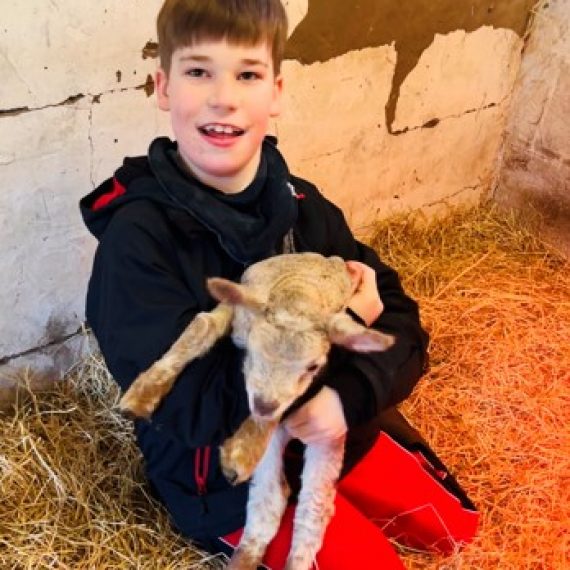
We first noticed wobbly episodes in Sebby at around 14 months. He would have trouble standing, became very lethargic and showed weakness on one side. His development began to really slow down at this point and he stopped meeting developmental milestones. He had repeated episodes of extreme fatigue, one sided weakness and head tilts. He had a number of tests and investigations, all coming back clear. We saw many professionals who could not figure out what was happening.
Eventually we were entered into some genetic research to try and look for a rare condition. Finally, 6 years after entering the research trial a result came through and he was diagnosed with TANGO2. Sebby needs support with most aspects of his development, including mobility, speech, learning, motor control and his health. He is remarkable! He is such a resilient boy who has a smile and laugh that will light up any room.
We focus on Sebby doing the things he loves and developing his skills of independence and learning. We hope that the research happening will help to promote the health of all of our young people and for professionals working with our community to better understand the disease and be able to efficiently and effectively treat and support TANGO2.
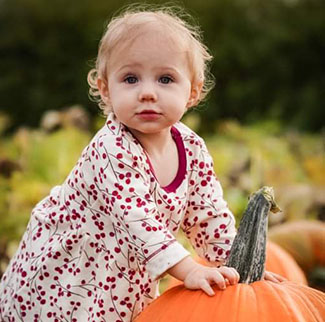
Harley met most of her milestones. She was a little bit slower to get crawling down and was just starting to hold on to things and walk all over. She then started to experience brief moments of ataxia where she would fall on the ground and get so frustrated that she couldn't get up or move the way she wanted. This happened a few times before Harley went into her metabolic crisis. We were out for a great family day on the utv trails, something we love to do together! Harley was feeling great that day with no signs of discomfort. She didn't even seem to be having a hard time with teething. About an hour after dinner, we put Harley in her car seat to get ready to head out for the night. Thirty minutes later Harley awoke and had thrown up a tiny bit. I rushed her out of her car seat to assess the situation at hand. I got her water and cuddled her to help her feel better. That was the last time I saw Harley Nova awake.
Once we got home, we put her down to bed. We had had a long day so when she didn't awake right away that wasn't unusual. The next morning, we tried to awaken Harley and she would not wake up. We rushed her to the Emergency room where they did lots of tests, drilled into her shins for fluids, and got her ready to be life flighted to Seattle Children's Hospital. For about 2 weeks we didn't know what was wrong with Harley. They believed she ingested something because her lactic acid was so high and sugars had dropped so much. With her being with us all day in the car, there was a very slim chance that she had gotten into anything! They took lots of tests and at this point everything came back normal.
They then decided to run the gene sequencing tests. A few weeks later we learned that Harley was diagnosed with the very rare, life-threating disease called TANGO2. This was a huge shock for us but in this case, we felt an answer was better than none. We are still receiving treatment for altered mental status, increased pressure in the brain and to optimize seizure medication.
We are on the path to go home and very optimistic with the strides she has been showing us! Our hope as a family is to just keep moving forward and live the best quality of life possible.
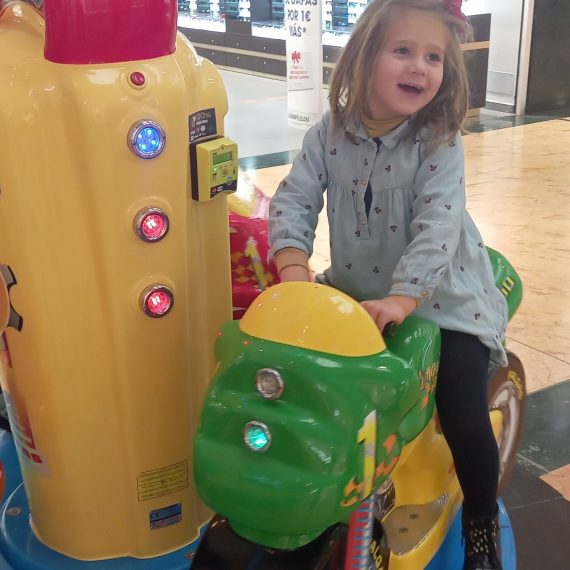
When Nora was born, we never imagined that such a special child would come to us! The first months of her life were completely normal. She only had a slight psychomotor delay to which no doctor gave importance... But when Nora was about 8 months old, she started having a parkinsonian tremor in her neck and then we knew something strange was happening to her.
Once this symptom passed, everything returned to normal, although in my heart the intuition that something strange was happening was already emerging.
During the following months and up to two years, she had two minor falls that triggered a fatigue attack with lethargy and excessive sleepiness that required hospitalization as she spent up to 4 days without waking up. At two years old she started with her first major movement disorder attack in the form of torticollis and her neck and head tilted up in a very strange way. That's when we realized that she was really sick.
Subsequently, these movement disorders recurred in different ways. Her neck turned up, her body leaned sideways, her legs became stiff, and there was instability as if she was dizzy and unable to walk. All these symptoms disappeared with time. She would rest and sleep and wake up again as a completely happy and normal child.
So, I had to record many videos of her to be able to show these disorders to the doctors since it was difficult for them to understand what we told them. They were as surprised as we were by everything. All the tests that she had done up to that point came out fine and unaltered (MRI, cerebral computed tomography, lumbar punctures, metabolic analyses, evoked hearing and sight potentials, electroencephalograms, etc.).
It was then that they began to study her genetics. It was there that it was discovered that there was a deletion in the TANGO2 gene on her maternal and paternal side, which is why she suffered from this rare recessive genetic disease.
We would never have imagined that Nora would have such a serious illness since she is a very active and happy girl despite a psychomotor and language delay.
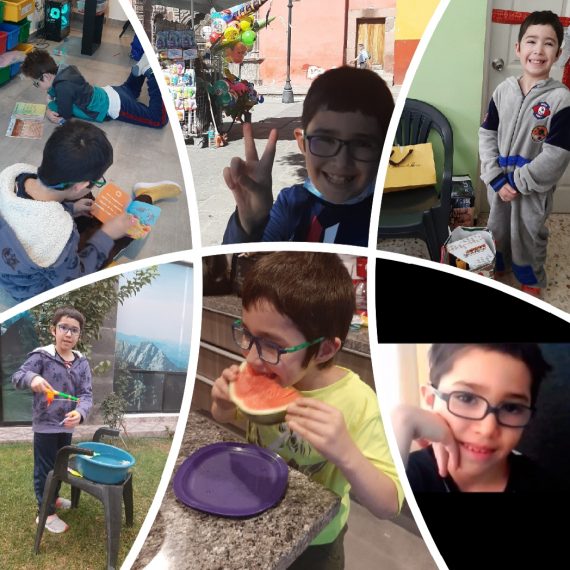
Querétaro México
Sergio Alejandro is 10 years old; he is a very cheerful and very tender boy. He loves animals, he cares about others, he likes music, dancing, art, playing video games, archery, going to the beach (but he doesn't like the feeling of sand) and he is a very good swimmer (in pool).
From birth to 3 years there were no symptoms, his development was apparently normal. From this age he started having vague and very general symptoms such as delay in language and social level, he preferred individual activities, he stumbled when running, most of the times he got tired faster than other children, he had shorter attention span and poor structuring in school activities, even so with the help of therapy he learned to read and write well.
It was until he was 5 years old that he began with symptoms such as loss of balance, gait and language alteration in a very evident way. These episodes lasted seconds or minutes and were sporadic until they became daily and constant.
He was 6 years old when the first well-established crisis happened, which lasted 45 minutes. There was weakness, gait disturbance, language disturbance and loss of balance with contracture of the right hemithorax backwards, presenting a subsequent cognitive decline reflected in school activities, mainly mathematics. From that moment on, multiple studies were carried out, all being normal, and until July 2019, the second crisis with weakness, gait and language disturbances, loss of balance, dysphagia, hiporexia, and sialorrhea did not present again, in addition to abnormal laboratories and electrocardiogram due to what we were referred by neuropediatrician with metabolic geneticist and cardiopediatrician.
Sergio was diagnosed with TANGO 2 in October 2019. Accompanying this condition is QT interval prolongation and dysarthria. Until today he is the only one documented in Mexico with this condition. In May 2020 he had a 3rd crisis with a very good recovery and since then he has been stable without any episodes. Sergio has not been hospitalized.
His mitochondrial cocktail is based on vitamin B1, B2, E, C, D3, K, Omega 3, COQ10, 30% Levocarnitine and Propranolol for his heart. Eats every 2.5 hours mostly the diet is carbohydrate monitored by his nutritionist. He has always remained within normal weight and height percentiles for his age. He has cognitive behavioral therapy, physical therapy, language therapy and structure of communication and swimming.
Sergio goes to primary level in normal school with constructivist methodology accompanied by a teacher guide because the structuring is very complex for him and some days needs to remind (or repeat) things he had already learned. Now he is aware of when to stop his physical exertion and rest, when he needs to eat, and when to take his supplements and medications.
Sergio has a younger brother named Elias and he does not have the disease. Elias is now taller and stronger, he helps to take care of Sergio.
We are grateful to be part of this foundation and to find this great family from whom we receive a lot of information and support. We understand and share what other families go through. We are here for you too. And like everyone else, with the expectation and confidence that researchers and scientists will find a treatment that can lead to a cure.
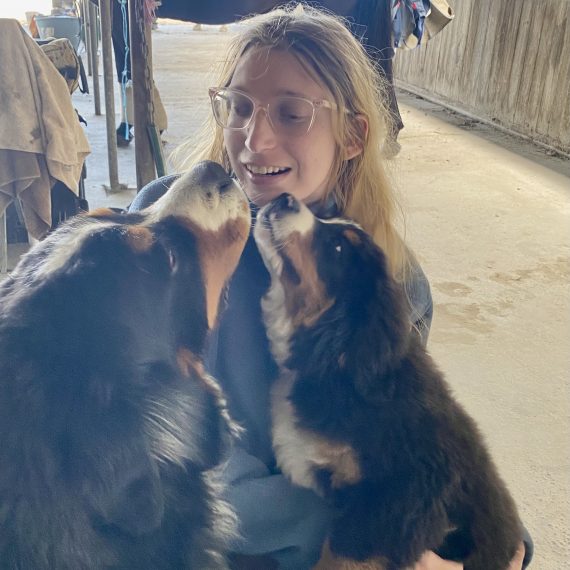
Asha was born via emergency c-section after a 48 hour labour; she had contracted pneumonia during the long birth and spent time in the NICU on oxygen and antibiotics. Ash started having seizures as a baby but these were not recognized as such till she was older. Her head stopped growing at around 6 months and by the time she was 12 months old her head was below the 2nd percentile. At around 10 months we noticed she was not meeting milestones, the doctor told us to come back in 6 months but Asha started having episodes of fatigue, drooling, leaning to one side, inability to sit up and acting as if she was sedated. These episodes happened within an hour of her waking and lasted for about an hour and left her lethargic and moody for most of the day. It was really difficult to get doctors to see it as we didn't have phones with cameras in those days and no one believed us. One day a nurse saw an episode and said it looked like a TIA.
Ash was eventually started on Carbamazepine, as the doctors thought it was seizures. She had terrible side effects and cried non stop so we stopped that drug and tried Sodium Volproate which seemed to help her stiffness and seizure type episodes but not the (what we now know) are TANGO2 fatigue episodes.
Over the next few years Asha saw lots of different specialists, she had MRI's, EEG's, blood tests etc. and was prodded and poked endlessly. She was diagnosed with epilepsy, Cerebral Palsy, microcephaly, paroxysmal dyskinesia and developmental delay. We started early intervention therapy when she was 2 and worked really hard to get her to walk (at 2.5 years), communicate (taught her signs as she couldn't articulate) etc.
Ash had a lot of problems with eating solids and would get tired very quickly when eating and her tongue would just stop working and food would get stuck in her mouth or throat and then she would throw up. We realised we had to feed her small amounts constantly to get enough calories into her. She also needed bottles of formula overnight and would wake at least 5 times a night needing help to move into a comfortable position or to be fed, she didn't sleep though the night until she was 4. Feeding Ash was my obsession, we made sure she had access to food all day long and when she went to school (special school) we had to fight with the school to get them to allow her to eat at any time and to make sure they fed her all the food we sent to school.
When Ash was 6 or 7 she stopped growing, she had always been on the 100th percentile for height and started dropping percentiles; eventually we discovered her thyroid had stopped working so she was put on thyroxine and started growing again. At around the same time she had started developing horrible side effects from all the seizure meds which we were giving her to try to control the episodes she was having, some seizure type episodes were controlled by the meds (sodium Volproate and lamotragine) but the TANGO2 episodes were not controlled although they were not as bad as they had been when she was younger. We decided to take her off all meds and give her glyconutrients, Ash was so much happier off the medication, her episodes reduced and we had three years of her blossoming, talking more and being really active and happy.
We decided to have another child and after further genetic testing on Ash we were told her problems were not genetic and probably from her birth. When our second child was born we were not as focused on Ash and got a little sloppy with giving her the glyconutrients and multivitamins and then out of the blue one morning she had a tonic clonic seizure and stopped breathing., she was 10 years old at this time. She had three more tonic clonic seizures over the next couple of months and was put back on sodium Volproate, and we eventually added Topiramate. By this time we were entering the tween years and Ash was growing quickly and started having more fatigue episodes, more choking and was very skinny and it became increasingly difficult to maintain her weight. Asha had always had a lot of difficulty with swallowing and food getting stuck in her esophagus and eventually at 17 she was diagnosed with eosinophilic esophagitis and after various food trials we determined she was allergic to dairy, soy and eggs.
Asha’s seizures have increased over time and she has been diagnosed with Lennox Gastaut syndrome and is on 4 different epileptic meds (sodium Volproate, topiramate, Frisium and Perampanal) sadly she is still having epileptic spasms on a daily basis.
As far as we know Asha had only had one metabolic crisis, a few months before her diagnosis with TANGO2 so we thought she had a bad seizure and treated her at home, she crashed and couldn’t walk unaided for 6 weeks and was very lethargic but we had been fobbed off at hospitals so many times we just decided to feed and hydrate her and care for her at home.
Last year we made the decision to have a PEG put in to make feeding Asha easier and so that we could get all her supplements into her. Feeding Asha has always been a mission and a cause for much stress and trauma so the PEG has been a blessing. Sadly Asha ended up having a metabolic crisis when it was put in due to the hospital arguing with me and mismanaging her feeding so she went into a catabolic state.
Ash was diagnosed with TANGO2 in January 2020 after taking part in a study to find a genetic cause for epilepsy. The diagnosis came as quite a shock because we had been living in ignorant bliss of the seriousness of her condition.
I am so grateful that I had the instinct to feed Ash constantly and that she has been strong and healthy over the years. I know that she is one of the older people with TANGO2 but I like to think that there are a lot more older adults out there living with TANGO2 who have not been diagnosed yet.
From reading other peoples' posts and stories, I see that some TANGO2 kids are more capable than Asha in many ways and I feel that the sooner a child is diagnosed and the more research that is done the more hope there is for young people to get the treatment they need to minimize the damage from this disease.
I hope that Asha’s story gives hope to other TANGO2 families. It is a scary, emotional and exhausting journey raising a child with a rare disease but it can also be the most rewarding and meaningful thing you do with your life. Asha is a precious soul and brings so much joy to our lives, despite the fact that she is a high maintenance princess 👸 😂 We would not change her in any way except to use all the information we can get our hands on to help make her life easier.
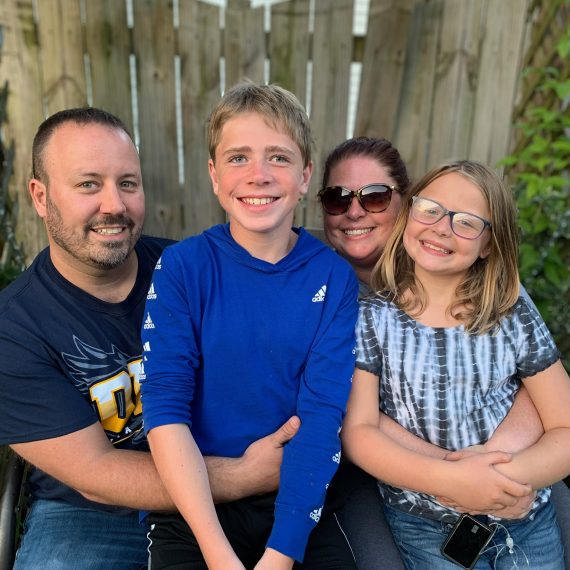
Collin was born about 6 weeks early and spent a couple of weeks in the NICU. He seemed to be a healthy and typically developing baby during the first year, with the exception of not walking independently. His pediatrician assured us that this was not something to be concerned about and that all babies develop differently. Just before 18 months, we began in-home therapies. Collin was still not walking, and it was becoming more clear to us that something was wrong. He was not developing like typical babies. Just before his second birthday, Collin had his first seizures. At that time we were referred to a pediatric neurologist, and we began the years-long search for a diagnosis. We saw many specialists, and Collin had many tests, with no answers. Collin continued therapies, and to our delight, began walking on his own! Every day seemed like a gift, and we were so proud of our boy. Eventually Collin was even able to stop taking seizure medicine, and for around eight years, he was seizure-free. However, he kept having what we called "drowsy episodes." He would lose muscle control, drool excessively, slur his speech, lean and sit in odd positions and act so drowsy. Nothing we did seemed to help. After more tests, we ruled out seizures, but his neurologist wanted us to try levocarnitine and a multivitamin to see if that would help. They helped tremendously and eventually those drowsy episodes became less frequent and ultimately went away.
Just before Collin's 13th birthday, he began having seizures again. Our tenacious neurologist was determined to find a diagnosis and ordered EXOME testing. About six months later I received a phone call from the doctor with a TANGO2 diagnosis. Collin’s seizures are under control, and he is currently a growing and developing teenager. We are grateful for each day and the gift that is our Collin.
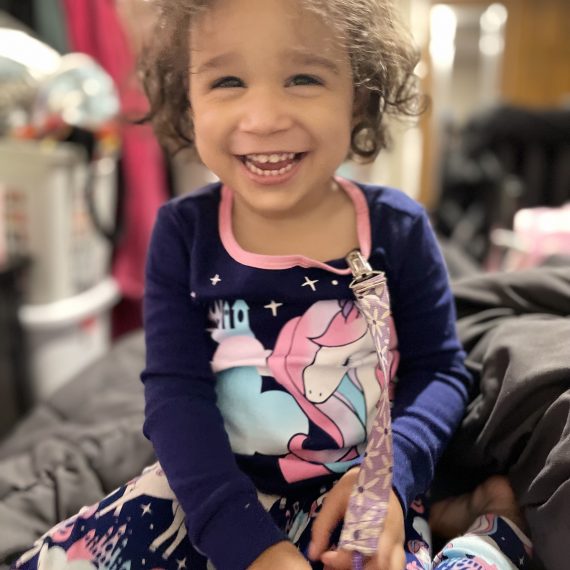
When she was 15 months old (September 26, 2020) I woke up and she was unresponsive. We immediately called the ambulance and they checked her blood glucose level and it was a 33. We were rushed to Stonybrook Children’s hospital where they immediately started doing whatever they could to keep her stable. She was kept sedated for a week. When they stopped the sedation, she woke up and almost immediately was back to the same Lillian she was before. We stayed another week for monitoring. While she was in the hospital, she had a irregular heart beat (a long QT) so when she was discharged she had to wear a wireless heart monitor for a week to see how her heart was.
Two weeks after discharge is when we got the results back with the TANGO2 diagnosis. Lillian had a second episode (December, 31 2020) of low blood sugar that resulted in hypoglycemia. We were discharged after 3 days of monitoring. The day after being discharged we got Lillian a Dexcom g6 and haven’t had any major incidents since.
Now Lillian is 2 1/2 years old and thriving. She is walking and loves to climb. She dances and plays with her sister like any other child would. You would not know anything was wrong with Lillian if you spent time with her. She’s incredibly strong and brave.
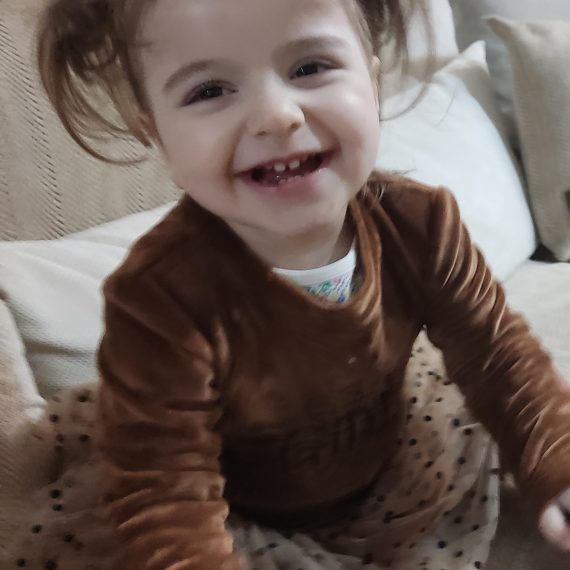
Marina was born like a healthy baby. She always liked to eat a lot and nothing seemed to be wrong with her until the age of 8 months. She didn't wrap toys easily but it didn't seem to make doctors worried. At the age of 8 months old she was vaccinated with the meningitis vaccine and exactly the same night after the vaccination, she began to have drowsiness and made unusual movements with her eyes. This led us to seek to find out what was happening to her. She did not need hospitalization and after a few days she recovered from drowsiness.
But eye movements continued to occur and she often looked tired. Initially she was misdiagnosed that she had an autoimmune disease. Electroencephalograms, MRI scans and many other tests were performed, all of which came back normal. Eventually we were advised to have a genetic test. The initial results were normal for her genetic code, but whole exome sequencing analysis showed a mutation in the TANGO2 gene. Initially, the doctors, not having much experience with this disease, considered that the phenotype of Marina did not match the TANGO2 disease. However, having not found anything else to explain the delay in her development, they agreed that this was the diagnosis. In the process, she showed mild hypothyroidism, dystonia in her legs while she has some episodes of fatigue and muscle weakness. Although she has a neurodegenerative disease, she seems to be developing slowly but in a good way.
She is now 2 years old sits stable, stands with support, plays in a very immature way, and says only baby expressions. She takes a vitamin cocktail which contains a complex of B vitamins, coenzyme q10, l- carnitine and DHA OMEGA. We hope that she is going to do things in her own way and in the end she will walk independently. She continues to eat well, seems healthy until now, and she hasn't had a metabolic crisis so far.
Hopefully we found a group on Facebook, which was made by TANGO2 parents. They helped us a lot. They suggested the vitamins cocktail and they help us anytime we need help. Doctors at the University of Houston also help us when we email them. It's not easy to deal with a rare disease and we are scared of the future, but we have hope. Children with TANGO2 disease are warriors and we hope that a cure will quickly be found.
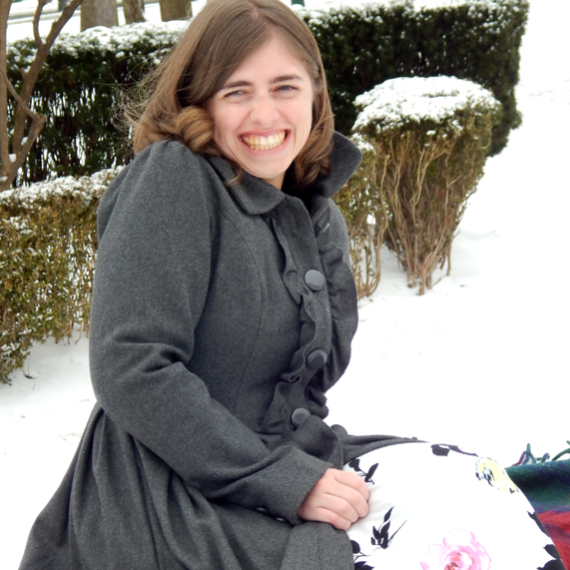
We live in Plymouth, Michigan USA, which is 15-minute drive east of Ann Arbor and 30 minutes west of Detroit.
Hanna is a proud participant in our community’s Special Olympics team, she is a graduate of the Plymouth-Canton community school’s vocational program for cognitively impaired young adults, and, she loves musicals, all things weddings and loves to shop for shoes and clothes.
Summary of Hanna’s symptoms that are consistent with TANGO2: episodes of ataxia/muscle weakness (mostly episodes of difficulty walking and talking) starting at age 20 months; speech/language impairment and cognitive impairment (recognized at age 3); amblyopia (age 4); seizures (age 17); hypothyroidism (age 24); and Whole Genome Sequencing confirmed TANGO2 at age 27 (February 2022).
We discovered her TANGO2 diagnosis finally - and unfortunately - when she was hospitalized with her first metabolic crisis in January 2022 at 27 years old. Although her providers initially did not recognize the metabolic crisis during the first 30 hours of inpatient care, when it escalated to ICU life-threatening level, Biochemical Geneticists became involved in her care and immediately suspected TANGO2. They cheek-swabbed my husband (Hanna’s father) and me (Mom) and took a vial of Hanna’s blood and two weeks later, thanks to whole genome sequencing, TANGO2 was confirmed. Hanna’s Dad and I (Mom) are both carriers – what a surprise!
Hanna has a 23-year old brother who does not have TANGO2 but may be a carrier (he will eventually have WGS to find out if he is a carrier).
So, while the symptoms of TANGO2 are not new to us, the diagnosis is enlightening! Hanna has now recovered from her metabolic crisis in January-February and is now using a mitochondrial cocktail and a slew of medicines (anti-seizure meds, beta blocker, blood thinner and hypothyroid meds). She is keeping well-hydrated, well-nourished and low-stressed. She is healthy for now!
We look forward to participating in the TANGO2 community, and learning and sharing experiences about this rare condition.

She attends a regular school, does therapy, and I notice small daily improvements.
My name is Dayane da Silva Lima de Oliveira, I am Brazilian born in the state of São Paulo. I am 35 years old and I am the mother of little Heloisa who is only 4 years old. On the 13 of May, 2021, my daughter, without any apparent reason, woke up with loss of movement in her legs. She remained that way for about 1 ½ hours with impaired motor skills, excessive salivation, distant gaze, and even difficulty speaking. She could not express the sudden illness, nor could she understand when we asked her to do things such as simple routine commands.
We became desperate and immediately went to the Sabará Hospital, where the grief to understand what was happening began.
Heloisa had 5 hospitalizations in only 10 months, several blood tests, MRI, X-ray, CT scan, tomography, electroencephalogram, electroneuromyography, a molecular panel test to withdraw lumbar fluid, and numerous anesthesias and sedatives. No changes or alterations were found and nothing brought a diagnosis. Her crises become more frequent and intense every day.
She had cardiologic tests such as Holter, echocardiogram and electrocardiogram which were normal, to our delight.
Still, what strikes me as odd was that 98% of the time when she had symptoms the symptoms were in the mornings up to 2 hours after waking up. It rarely occurred in the afternoon and many times they appeared and disappeared without any medication or apparent reason. On some days, the symptoms remained during the whole day and for a few times they only occurred in the afternoon without occurring in the morning.
We saw many medical specialists, such as: otolaryngologist, otologist, allergist and immunologist, physiatrist, endocrinologist, nutritionist specializing in innate metabolic errors due to genetic alteration, homeopath, orthopedist, rheumatologist, 3 neurologists, cardiologist, electrophysiologist, and a neuro-pediatrician specializing in metabolic inborn errors and genetic alterations.
After this long journey trying to find a diagnosis, she had the Whole Exome Sequencing test and we received the diagnosis of TANGO2-related disorder.
With the diagnosis came a great and unexpected surprise, because, we (Heloisa’s parents), we’re not related in any way.
Due to the genetic alteration and the diagnosis, we learned things that we did not know at the time: Heloisa was born 37 weeks premature and until she was 6 months old, she was a child who cried a lot. I always noticed that in the milestones of life, such as walking, crawling, and sitting, she always took longer than other children, but always managed to achieve very close to the due date – with the exception of speech. She has a very significant delay and learning difficulties.
Our great desire and dream is a cure for TANGO2 or medications that control the disease.
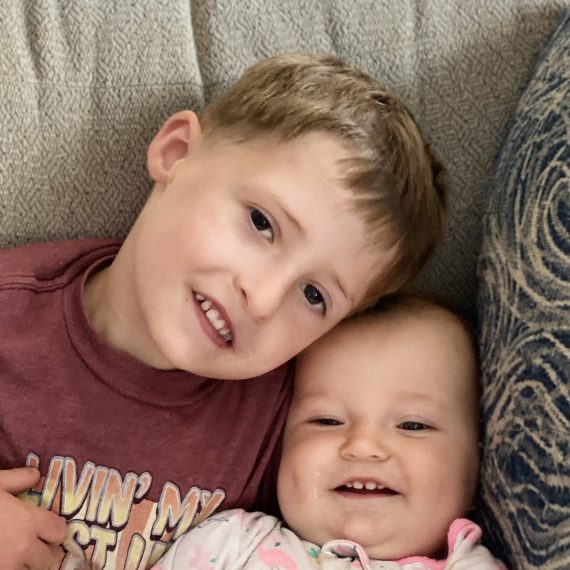
Parker's general symptoms include episodes of weakness in his legs and temporary loss of mobility. We have noticed that the symptoms typically occur when or after he is sick. When Parker has any type of symptoms, we make sure to inform his doctor so they can keep good notes and track the pattern.
As all of the families do we hope to one day find a cure or to make these episodes more manageable. He is 4 years old (as of Sept. 2022)
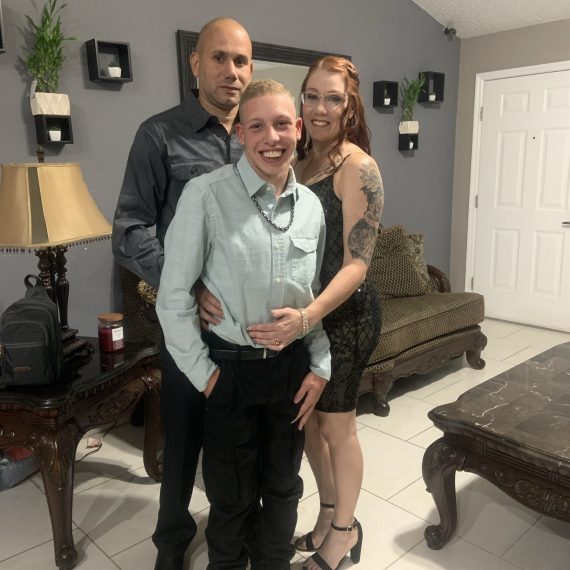
When Kris turned 1 and a half years old, he stopped walking and talking and he started getting seizures. He had many, many labs and treatments, but no one ever told me what was wrong with him. I gave birth to my daughter Kimberly and she started having the same issues. She passed away when she was 6. We moved to Florida between 2017 and 2018 when Dr. Amaryllis Sanchez performed a genetic test on Kris and that is how we found out about this rare condition – TANGO2. Kris has turned 18 years and has started having seizures once again.
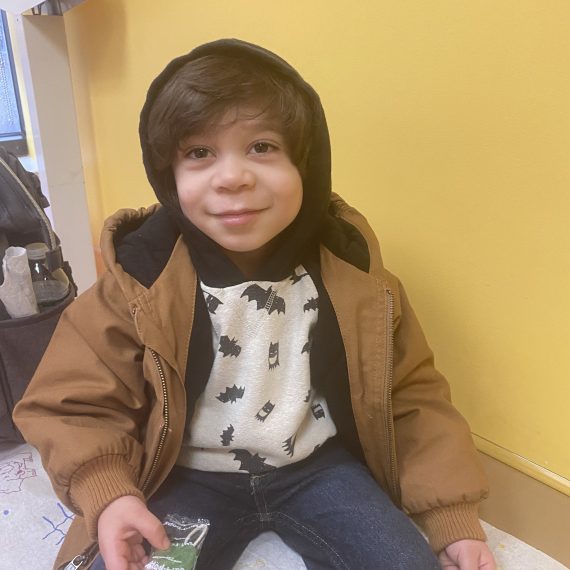
His first symptoms started around 13 months after a breath holding spell. The next day he had leg weakness and couldn’t walk. It kept happening off and on. We finally saw a neurologist and she thought maybe it was dystonia or hemiplegia. She referred us to a genetics specialist and they did a dystonia panel and microarray and everything came back fine. They did a whole exome sequence and after 6 months, the genetics doctor called on a Sunday and I knew it was something serious. We are glad we found out early. We now have some information, even if it’s not much, to help prevent a metabolic crisis. Aaron’s challenges are his speech – he doesn’t say much and what he does say is not clear. He also is having some low energy recently, but that is all – so we don’t complain because we know things could be worse.
My hope is that Aaron enjoys his life and is aware of how loved he is. He is the best thing that has happened to me and I cherish that everyday.
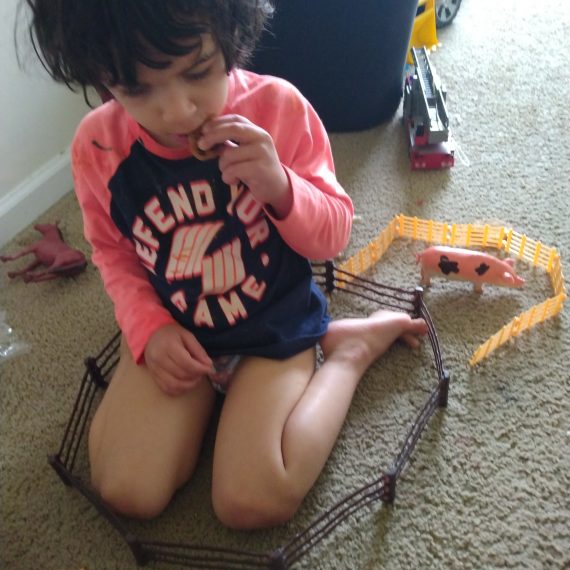
Osiris went into his first metabolic crisis at 5 months and was life-flighted to an out of state hospital. Because of his brother's hospitalizations, the medical team during admission were all comfortable treating and looking for a more definite cause. By the time he was discharged, we had suspected TANGO2-related disorder and had protocols for both boys. After a few months of testing, he was diagnosed with TANGO2 at age 1.
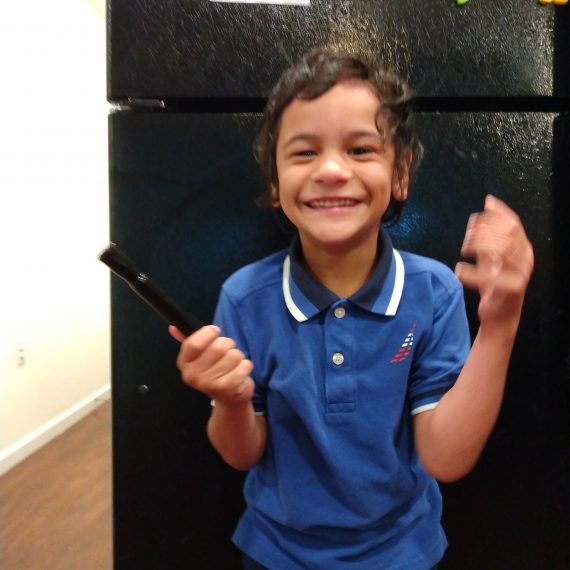
At 9 months, he went into his first metabolic crisis and was transferred to an out of state hospital for specialized care. He was diagnosed with TANGO2-related disorder at age 3 after his little brother (Osiris) went through the same metabolic crisis.
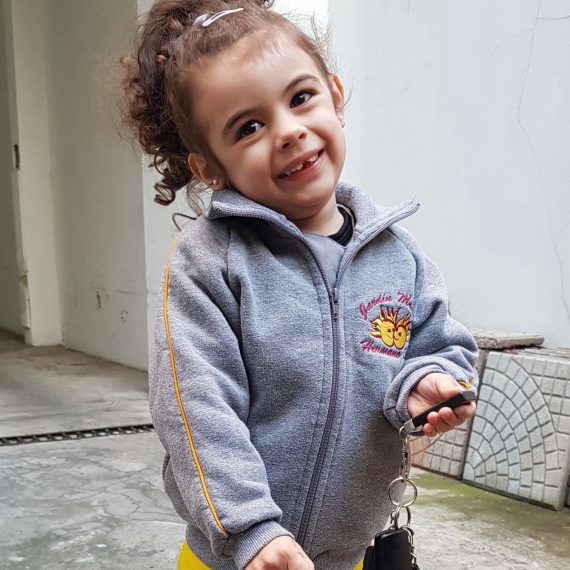
As time went on, although she reached the milestones, she did so with a little delay. They told me not to compare her with other children, that they all have different development, and they were not concerned.
At 19 months, after a walk, she began with episodes of gait disturbance, loss of balance and twisting her trunk. We knew something was not right. It was there when we began with hospitalizations and studies. They performed blood tests, CT scans, MRIs under general anesthesia, and polysomnography. All studies yielded normal results. Sol was medicated anyway while she continued being examined. Finally a doctor instructed us to have the Whole Exome Sequencing test. And at 29 months we received the diagnosis of TANGO2-related disorder.
A confirmatory test was then indicated, which confirmed it. We also had a genetic test and it showed that both parents are carriers.
Sol has a 6-year-old sister. They adore each other. At the moment we have not done a genetic test. We estimate that when you want to have a family, the genetic consultation will be carried out. She has not presented symptoms.
Today Sol is only 3 years old. She helps in the garden, does therapy (phonoaudiology, psychomotricity). She really likes symbolic play.
She presents alteration in gait currently almost daily, instability and loss of balance. She also has developmental and language delays. She has great communicative intent, but her words still take time to arrive. She says just a few words. She has attention deficit disorder, and is very restless. She is not a big eater, and that is why we also consult with a nutritionist and we are very attentive to this issue, with great insistence that she eats.
She takes a mitochondrial cocktail (vitamin B1, B6, B12, riboflavin, carnitine, creatine and coenzyme q10). In turn, she is medicated with T4 due to hypothyroidism.
She likes to play a lot, dance, and she is very affectionate. She gives super cute hugs. At times she is also very annoying and throws a lot of tantrums! Haha.
We want the research to advance quickly and allow us to improve the quality of life of our little ones. They deserve to be better. Being able to enjoy a day full of running, jumping, and climbing, without worrying about repeated visits to doctors, vitamins, therapies, etc.!
I ask you to help us 🙏🙏 and together let's collaborate with the researchers. The pain that we have when seeing our children affected by TANGO2 is inexplicable. Thinking of a rare disease, without a cure or treatment is extremely sad. But, we know that researchers will help change this. Please help us finance the research.🙏🙏
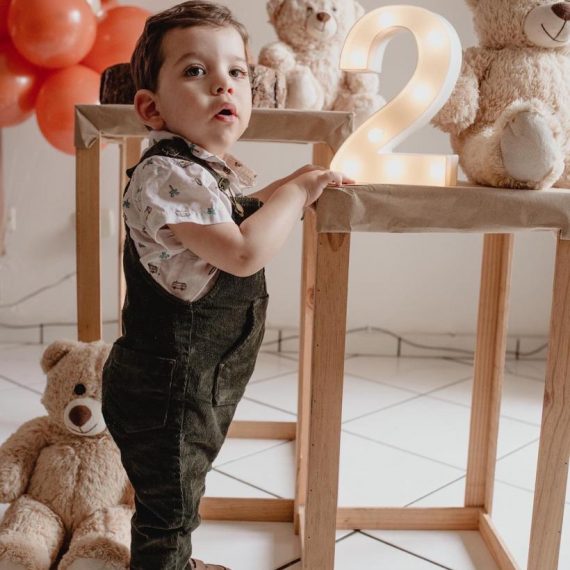
He had the normal developmental milestones for his age until 9 to 10 months old when he had a metabolic crisis, a constant fever, spots on the body and loss of movement in the arms, legs and neck. He had a lot of pain, especially in his legs. His CPK reached 74,000 and other significant changes in some enzymes; he had an enlarged liver, spleen; high blood pressure; and dysphagia and needed to be fed through a tube. They didn't know what his diagnosis could be because all the exams were normal. They hydrated him with a lot of serum and gave him pain medicine. After around 3 weeks he started to feel less pain and gradually regained his movements with the support of physiotherapy. He was discharged after approximately 20 days of hospitalization, with changes in blood tests practically normalized.
After that, Vicente had his blood tests normalized, but he started to present intermittent strabismus and 5 months after the metabolic crisis, every time he gets sick he becomes hypotonic, lethargic, very tired, with dysphagia and drooling. It sometimes only lasts for a period of the day and sometimes it lasts for days, with comings and goings of these manifestations.
After almost 1 year without diagnosis, in one of the genetic tests the diagnosis was made that he has TANGO2. When he had the crisis he was already crawling, but after the crisis he has ataxia and even today at the age of 2, he has not started to walk, but he stands practically without support, he climbs on things, and he has already taken two steps in physiotherapy. He has speech delay, speaks only a few words. Vicente has recently had a seizure episode and is experiencing paroxysmal torticollis.
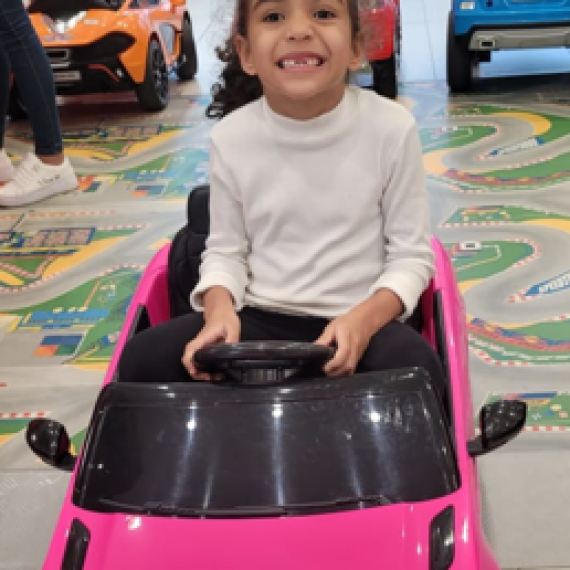
Rafaela had a typical development, although she was a quieter baby, she always had her milestones reached within the time limit. The only development issue that caused us concern was her speech. We decided to enroll her in a little school at the age of two which did not bring much result, but we let it happen in her time and it really did happen. Rafaela had many respiratory infections which got worse after going to school and after three months attending school she had pneumonia with atelectasis. She was hospitalized for five days.
Between 2 and a half and 3 years, she presented with ataxia. Her pediatrician was informed, and advised us to observe because it was a very quick episode. After some time it happened again and a cranial tomography was requested, which showed no changes. Ataxia always occurred in a very spaced way and when it occurred it was in the morning and after lunch and afternoon sleep he woke up as if nothing had happened.
Faced with the insistence of this symptom, an MRI was also requested, which returned normal. We were referred to the neuropediatrician who, after many tests without results, requested the Whole Exome Sequencing test where the TANGO2 deletion was found in July 2020.
After this test, her symptoms got worse and what happened only in the morning and on alternate days, started to happen all day and every day. The peak of ataxia was in the year 2020 and 2021, and always in the cold periods it intensified even more. In January 2022 Rafaela had her last episode of ataxia, but a decline in speech was observed, where today she has nasal speech that varies in intensity.
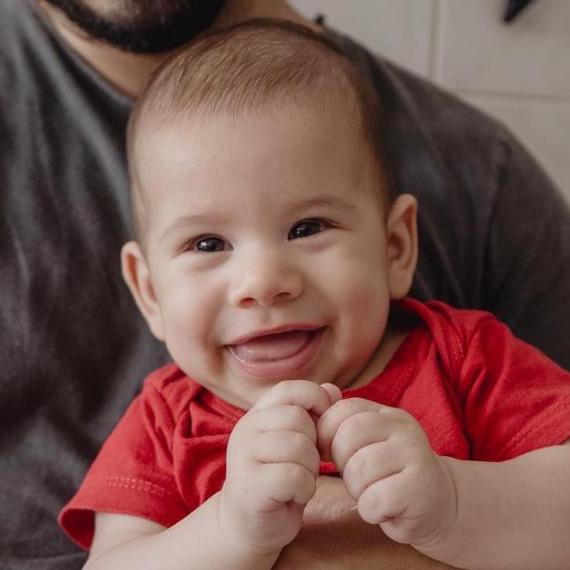
He is of normal development for his age and has no symptoms of Tango 2 to date, has had no metabolic crisis and seizures.
Rafaela had a typical development, although she was a quieter baby, she always had her milestones reached within the time limit. The only development issue that caused us concern was her speech. We decided to enroll her in a little school at the age of two which did not bring much result, but we let it happen in her time and it really did happen. Rafaela had many respiratory infections which got worse after going to school and after three months attending school she had pneumonia with atelectasis. She was hospitalized for five days.
Between 2 and a half and 3 years, she presented with ataxia. Her pediatrician was informed, and advised us to observe because it was a very quick episode. After some time it happened again and a cranial tomography was requested, which showed no changes. Ataxia always occurred in a very spaced way and when it occurred it was in the morning and after lunch and afternoon sleep he woke up as if nothing had happened.
Faced with the insistence of this symptom, an MRI was also requested, which returned normal. We were referred to the neuropediatrician who, after many tests without results, requested the Whole Exome Sequencing test where the TANGO2 deletion was found in July 2020.
After this test, her symptoms got worse and what happened only in the morning and on alternate days, started to happen all day and every day. The peak of ataxia was in the year 2020 and 2021, and always in the cold periods it intensified even more. In January 2022 Rafaela had her last episode of ataxia, but a decline in speech was observed, where today she has nasal speech that varies in intensity.
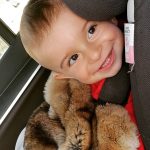
When he was born he seemed to be a healthy baby, but after a few months we understood that something was wrong because he always used to cry night and day and lie in a strange position with his head turned on one side and with a lot of regurgitation. The doctor supposed it was a MRGE reflux disease and treated him with esomeprazole.
At the age of ten months, during the night he woke up suddenly crying, his head turned to the left side and his eyes rolled back and he became unresponsive for about five hours, we called the emergency number and at the hospital, they checked on him with many exams – heart, fluids, etc. – but they didn’t find anything, so according to the neurologist opinion we decided then to further investigate the causes of his condition: he was suspected of epilepsy, but until today every EEG was negative, from the two MRNs done during last two years they found two big arachnoid cysts, dilatated ventricles, and a slight lack of myelinization, but no one has never been able to explain what was the cause of Lorenzo’s disease.
In Italy it is very difficult to have access to the Whole Exome Sequency, not only by the public health system, but also by private companies because of bureaucratic barriers system; so only in May of these year, after a long bureaucratic battle (1 year), we had the possibility to make the WES and then we received the TANGO2 disease diagnosis. Obviously it was a shock, not only for us, but also for the doctors that never believe Lorenzo was affected by a so severe disease.
Form this moment all of us, (parents and doctors) have the opportunity to help Lorenzo and this is the good news.
Lorenzo has always been late in reaching the growth milestones, and always struggled with episodic bouts of muscle weakness and paroxysmal torticollis and other neurological and muscle-related issues that put him down. He started to stay seated at the age of 15 months, crawl at the age of 18 months and to stand up only at the age of two, with the help of somebody. Now with AFOs, thanks to every day physiotherapy and he is starting to take a few steps. He doesn’t speak and his vocabulary is limited to these two words: ‘mom’ and ‘dad’, but every day thanks to the love of his angelic and sunny baby sitter Maria there are little improvements and we believe in him and in these good signs.
We are very grateful to the TANGO2 community and all the members of TANGO2 Research Foundation and the Facebook group, which immediately helped us after the diagnosis. In that way, we were able to start giving the mitococktail, which improved Lorenzo’s condition.
Lorenzo has an older brother and a guardian angel, Ettore, whose genetic tests results we have just received this month, showing he is not affected by TANGO2 disease.
As parents of a TANGO2 disease child, we know that there is a concrete risk that the good times will not last forever, and for this reason we know how important it is to join and support the work of the foundation and share all the stories and knowledge about this disease.
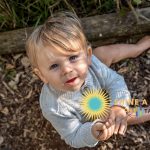
Jake was born a healthy baby, and for the first year there was no reason to suspect he had a life-threatening illness. Around 1.5 years old, his development plateaued, he was frequently sick, and then on a daily basis began to struggle with unusual “episodes” having ataxia symptoms like extreme lethargy, loss of muscle control, muscle stiffness, excessive drooling, unfocused eyes, and loss of balance. Despite numerous physician and emergency hospital visits, blood tests, neuromuscular tests, EEGs, MRIs, and every possible screening, no one could explain the seizure/stroke-like episodes. Jake was no longer making his milestones and having daily neuromuscular attacks when he would lose his ability to function…he couldn’t use his hands, sit, or hold his head up, he’d choke on food from difficulty swallowing, and sometimes he was barely responsive. As the frequency of these episodes increased, Jake’s overall condition deteriorated and he regressed in his abilities. We received this diagnosis and ironically, the Covid-19 stay-at-home order was somewhat of a “blessing in disguise” for us because it kept Jake home safe from illness, giving him time to recuperate.
Because of TANGO2, Jake has global developmental delays and has challenges keeping up with his peers. He receives physical, occupational, and speech therapy which really help his development. Even without words, he finds ways to communicate and is working hard to learn how to talk and gain physical and mental endurance. In the 3 years since his diagnosis, Jake takes a mitochondrial cocktail of vitamins which have significantly improved his quality of life, kept his baseline health stable, and he has been episode free for 3 years now! Because he is more susceptible to coming down with illness and it takes him longer to recover with threat of hospitalization, we closely monitor Jake's nutrition and energy levels. In hindsight, Jake’s recurring illnesses could have resulted in a metabolic crisis and we are ever so grateful that his sickness never reached that point…Information from The TANGO2 Research Foundation made us aware of triggers and early signs of a metabolic crisis, and mostly important how to monitor and protect Jake.
Jake has taught us not to take things for granted. He often reminds us to live in the moment and to find joy in the things that matter most. He’s a very affectionate, happy, and continues to bring an abundance of joy to this world. The thing we always say about Jake is that he has brought so much sweetness to our life, and taught us about unconditional love. We want to remain optimistic about his future.
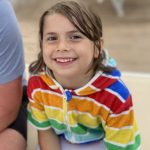
We are so grateful to have Phoebe reminding us what matters in life and how to enjoy life to the maximum.
Phoebe appeared to be developing normally until age 2 when she developed a nasty cold when she kept falling over. It was thought she had an ear infection and she initially improved but then a few weeks later she started walking strangely and kept falling to one side. She had several episodes over a couple of days and was rushed into hospital for bloods and a scan. The CT scan was normal as were her bloods and we were reassured she still had an ear infection and she probably had vertigo.
Again Phoebe bounced back but within a month was having more episodes. This time we were admitted and she had an MRI and referred for a neurologist reviews. It was eventually thought she had episodic ataxia despite negative gene panels.
We tried a couple of medications for this but nothing really helped.
From age 4 we began to recognise Phoebe had learning difficulties, speech difficulties and more regular mobility issues.
Just before the diagnosis we were having daily episodes of slurred speech, drooling, wonky walking and agitation. She was intermittently using a walker and wheelchair.
Finally in Feb 2023 we were surprised to finally be told they had found a diagnosis that tied it altogether.
Tango2 was the explanation to so many questions. It explained what we couldn't understand about her daily wobbles. And most importantly it has helped us protect her. The B vitamins recommended have in just a few weeks given us a girl who can now run!
For that we are immensely grateful.
Now we need to continue understanding and growing our knowledge about Tango2 to help these children achieve their potentials and stay safe.

Pasan días y vuelven los síntomas a parecer sus piernas se pusieron rígidas y había inestabilidad como si estuviera mareada y no pudiera caminar. Todos estos síntomas se desapacireron con el tiempo .descansaba, dormía y se levantaba normal y tan feliz. En 2019 hemos venido a España y volveremos a hacer todas las pruebas y análisis,que hemos hecho en nuestro país pero todo bien. Entonces tuve que grabar muchos videos de el para poder mostrarle estos trastornos a los médicos ya que les contaba entender lo que les decíamos. Ellos quedaron tan sorprendidos como nosotros por todo.
Todas las pruebas que habían realizado hasta ese momento salieron bien (resonancia, tomografía, punción luchild.mbrar, electrocelofegramas,etc)
Fue entonces cuando comenzaron a estudiar su genética allí donde descubrió que existía una delección en el gen Tango2. Nunca hubiéramos imaginado que imrane tendría una enfermedad tan grave ya es un niño alegre y cariñoso.
Imrane is an 11 year old boy. He really likes playing football and his role model is Cristiano Ronaldo. When Imrane was born, we never imagined that such a special child would come to us!! The first three years were completely normal. But after three years he began to have many difficulties, for example with language and walking.
He took him to the hospital but when he arrived at the hospital the child came back normal, the doctors will do all the tests and analyses, x-rays, everything turns out fine, he has nothing.Days pass and the symptoms return, it seems like her legs became stiff and there was instability as if s he was dizzy and couldn't walk. All these symptoms disappeared over time. He rested, slept and woke up normal and so happy. In 2019 we came to Spain and we will do all the tests and analyzes again that we have done in our country but everything is fine. So I had to record many videos of him to be able to show these disorders to the doctors since it was important for them to understand what we were telling them. They were as surprised as we were by everything.
All the tests they had performed up to that point came out well (resonance, tomography, lumbar puncture, electrocellofegrams, etc.)
It was then when they began to study their genetics where they discovered that there was a deletion in the Tango2 gene.
We would never have imagined that Imrane would have such a serious illness, he is already a happy and loving

We didn't know anything about Tango2 until John at the age of 17 started having seizures, his neurologist ordered some genetic testing and in December 23rd, 2022 his neurologist received the news about the Tango2 and contacted us to informed us about the bad news.
John's challenges are everything related with math, his journey has been ok towards the diagnosis.
Our hope is that one day we find a cure for the Tango2 disease.
John's dream is to meet Cristiano Ronaldo, Bellingham or Mbappe from Champions league in Europe.

As a baby Joseph was developing normally and meeting his milestones until he was about 15 months of age and started to walk unsupported. It became obvious to me that there was something not right. He struggled to move forward and tilted to one side. It was not until I requested an appointment with a paediatrician who tested Joseph's neurological responses that a problem was acknowledged, and he was referred to a neurologist. Joseph then began having periods of severe weakness where he would lose all function mid- morning but be toddling again by the time I got him to the specialists’ rooms. This was before mobile phones and computers, so evidence was difficult to capture. He had periods where he would be asleep by 5pm and not wake until 7am. Joseph continued to decline and at one point the Neurologist thought that Joseph had a life-threatening issue involving his spinal cord and sent us to Sydney to see a neurosurgeon. This assumption was found to be incorrect. The Neurologist put Joseph on Tegretol and Anafranil which seemed to slow the significant decline. When Joseph was 4 his dad passed away from a heart attack. He was 35 years old. Joseph, his little sister Emily and I continued this journey together with the help of my beautiful parents. Joseph continued to have severe episodes of weakness, walking difficulties and seizures and spent most of his early years in and out of hospital for testing. This slowed as they ran out of testing options. Joseph was one of the first patients to have an MRI scan in Australia. We had to fly to Sydney again for the scan. The building that housed the MRI machine was specially built, lead lined and very large.
Joseph had ataxia and dystonia but managed to walk mostly unaided during his school years. One foot turned inwards and he dragged his toes. He had intermittent periods of weakness, lack of coordination and speech difficulties and we found that his energy was depleted by mid day. His most difficult period was during puberty. He had varying degrees of difficulty with his function however during one specific episode Joseph gradually lost all function. He had difficulty focussing and he could not hold his head up walk or talk or hold his saliva. It was determined that he was having a type of seizure. He took weeks to recover and suffered from repetitive movements of one hand for some time which I was told was also a type of seizure activity. I still do not know what was happening for him at that time.
When Joseph turned 18 years of age, his Neurologist moved away from private consultation. This caused us to seek a new specialist. I took Joseph to a different Neurologist who was at that time interested in looking at the benefits of the B group vitamins in supporting neuro-transmitter function. He put Joseph on Vitamin B6 and B3. Joseph remained on B6 vitamin until this year. Joseph’s speech, mobility, swallow and communication continued to degenerate very slowly, but the severity of the episodes decreased.
Joseph was diagnosed with Tango 2 Deficiency Disorder in March 2024 at the age of 40 because of genome sequencing. He is now on B complex containing all 8 Bs. I am observing major improvements in his pain levels, his anxiety and at times his concentration. Joseph has only been on the complex including 500mg of B5 for a short period of time. I am very hopeful that he will continue to improve.
I am so grateful for the diagnosis as Joseph can discontinue several drugs that we now know are unnecessary. He has been referred to a cardiologist for a complete cardiac assessment. We are awaiting an appointment with an Endocrinologist and will be seeing the Metabolic Clinic at the Mater Hospital next week and remain under their care. My daughter Emily will pursue genetic testing to find out if she is a carrier. Emily has two healthy little girls now and it is important for them and our family to understand the possible implications of this disease.
This has been a lonely journey, as Joseph’s condition has been such a puzzle. Now, not only do we have answers, but we are now connected with a wonderful supportive group of families and medical experts who really understand the journey that we are all travelling.

Elisa is a cheerful, kind and affectionate child. She started to walk on her toes when she was 2 years old. One day, she got very sick. We took her to all the doctors, but they could not be diagnosed. In the last genetic test, she was diagnosed with Tango2. She was very tired and weak before, but now B vitamins have helped her very well. She is happily receiving physical therapy. We are trying to increase language development.

Megan is a little shy when she first meets people but after a few minutes she turns into a chatterbox.
Loves her Rottweiler named Thor.
First spell was at 6 months during a Disneyland trip. She was misdiagnosed with VLCADD
But later was corrected after the study was completed.

Maria loves water , to drink , to swim , to play ... where there is water she is the happiest .
She loves to be outside , she loves animals ( special dogs ) and kids .
She is full of energy all the time and hates when we place her to sleep.
Loves cuddles from her mum and playing with dad .
Maria had no symptoms of tdd until she was 14th months and staff from kindergarten tell us that she had a head tilt . We took her to doctors that week and all good. Then the worst day of our life's came next Monday , when we got a call from kindergarten that she wasn't feeling good . She didn't want to eat . We took her home , try to give her food and she refused . She didn't want to sleep neither. At some point she vomited a kind of foam and fell a sleep without waking up anymore. Ambulance came , her blood sugar was 1 . We rushed to the hospital where they did a scanning that showed huge brain damaged . She was intubated next morning. Since her blood samples had strange numbers , thyroid , high ck , low sugar , doctors couldn't find a reason for such thing and did a complete set of genetic tests that came up with tango2.
Maria was hospitalized 6months as he had many complications. She suffered withdrawals from the sedatives , she have a hand " damaged " from a catheter , she had a hospitalar bacteria and kept vomiting for 2months until a sepsis infection showed up .
She did an emergency surgery where part of her colon was removed , and she have 2 temporary stoma's .
Nowadays she is on a rehabilitation center .
We were told 3times that Maria won't survive . We were told endless number of times that she won't walk , talk , eat , etc due to her brain damages but she not only survived to her initial metabolic crisis , as she won against a sepsis and she is crawling, standing, seeing , eating and full of energy . Maria it's on b complex and multivitamin since we got tango2 diagnosis .

Rebecca (Bec) our youngest and 4th daughter was born a healthy beautiful baby in1994. We had lost her sister Samantha our second daughter in April 1990 with what we now know to be TANGO2 deficiency disorder (see Samantha’s angel story). Bec was initially fine for the first 8 months and then Sandi, as a mum, was starting to become concerned as Bec was slow – unsteady sitting up and she was not yet crawling. We saw the paediatric neurologist at 11 months, and he said she was still within normal developmental limits and to bring her back at 14 months if we were still concerned and they would then organise some testing.
At 13 months of age Dave found Bec in the cot unresponsive in the morning. We rushed her straight to emergency at the regional hospital and Rebecca was put on the same bed we had lost Samantha on 5 years earlier. It felt surreal and we somehow stayed quite calm knowing that we had to advocate strongly for our daughter as this was unbelievingly happening again.
The pediatrician on call when he examined Bec didn’t find anything significantly wrong and gave instruction to the nursing team to give her Dilantin as she must be having some sort of seizure. Dave was lecturing medicine at the time and challenged the paediatrician on this call.
The State government had decided to register practitioners of homeopathy, one of the medical applications of hormesis alongside vaccination and allergy desensitisation. As a biological scientist Dave had spent several years involved in a phenomenon unique to biology known as hormesis - a 2-phase biological response effect where high doses of a chemical or certain types of radiation have an inhibitory or destructive effect and low doses have a stimulatory effect. The stimulatory component has applications both in agriculture and medicine. As a result, he was tasked with adapting the American Physician Assistant training to the Australian standard and then found himself lecturing medicine and homeopathic treatment.
The discussion with the clueless paediatrician was brief as the head of the emergency department still in his flying suit, who had just flown in on a helicopter, called us over to a corner of the room to ascertain the story. We explained that we had lost our daughter on this bed 5 years earlier whilst being told go away, there was nothing obviously wrong. He did a quick examination and then the next 2 minutes were all action. The discussion was “we are about to lose her; looks like she is having hepatic encephalopathy: and intubate her immediately and get her onboard the chopper to fly her to Brisbane ICU”.
We didn’t know when we drove down to Brisbane if Bec would still be alive when we arrived. Rebecca was in the ICU for about a month and there were many times we thought we would lose her. She was then transferred to the general wards and our whole family were fortunate to be given a unit on the hospital grounds and our children attended school at the hospital. It was a critical time trying to work out what was going on. One memorable and important day where Bec’s eyes were rolling constantly for about 12 hours the neurologist came in and was concerned that her brain needed sugar, so they put dextrose in her IV line and she improved immediately even though her blood sugar was not low. After a few months we eventually took Bec home.
We learnt that everyone time Bec looked a bit flat if we rushed her to any hospital and asked to get a dextrose line up immediately Bec would immediately sit up in the cot like nothing had happened. It was amazing and often the Doctors would not believe us as her blood sugar was n ormal and we would make a fuss, insist on getting the line in and they would be amazed at the instant response. We eventually had a Port-A-Cath inserted knowing the importance of the dextrose in whatever was happening, and we maintained this at home. However, at this same time of putting the Port-A-Cath in, the wonderful metabolic specialist doctor who Bec came under, stood at the side of her bed and said “Sugar! What does sugar do to the body?”. He came back the next day and said he would like to try two things, and we said we will do whatever to help Bec. The first step was inserting a naso-gastric tube as she was failure to thrive and needed nutrition. The second step was giving her a bolus feed of corn cornstarch every few hours as it was the slowest release glycogen or sugar that you could have in the body. He said she doesn’t have a glycogen storage disorder but let’s treat her like one as he suspected there was something happening with the mitochondria and either nutrients (lipids) were not crossing the cell wall or there was an internal mitochondrial problem.
Bec was just over 2 years old at this time and our lives changed. Bec no longer had the episodes, and we were not rushing to the hospital for glucose drips. The Port-A-Cath was not needed at all, and we maintained this at home for a year. At one stage we had to access a hospital to help with the maintenance (heparin to keep it flowing) and Bec picked up an infection in the Port-A-Cath site. We decided to take it out as it hadn’t been needed since Bec started on the cornstarch boluses. We nearly lost Bec again firstly with the infection and then with the side effects of the antibiotic prescribed (flucloxacillin) which her liver did not tolerate.
Bec stayed out of hospital basically since that time (28 years) and she has not had more major metabolic crisis except for if a feed is missed. As a family we knew and recognised when she was ‘not right’ and had learnt what was needed – rest her, don’t push her too hard, make sure she had this strict regimen of bolus feeds and when and if she didn’t have a feed, we knew Bec would be hospitalised the next day. We knew and understood because we had lost Samantha that this was life threatening, but we never knew why, and neither did anybody else. We have had to advocate strongly for Bec every day since to make sure she is ok. We often described caring for Bec as being super vigilant every day and watching her all the time to see how she is going but we have tried to live a very normal life, and we have worked hard to make sure Bec has had a great life.
Bec did have the nasogastric tube for 9 years and we changed this as a family every week (swapping sides so that it wasn’t on the same side all the time). Bec had been a voracious eater as a baby but when she was so ill in hospital and for about 3 years after this time she relied on the nasogastric feeding and didn’t eat anything orally at all. Her sisters eventually taught her to eat chocolate. We worked for so many years to get Bec to eat orally as well as keeping up the strict nutritional regimen she was on with enteral feeding. Bec had the nasogastric until she was about 12 and then everyone said to us it would be good to have a mic-key button inserted. After the experience with the Port-A-Cath and us nearly losing Bec we were very resistant to inserting anything foreign into her body as we knew there could be risk of infection. We were being very cautious and selective about medical interventions after our earlier experiences and some advice from a specialist who had caught us in a hospital lift years before and advised the best course for us was to aim to keep Rebecca out of hospital and away from hospital germs.
Bec had the mic-key button inserted and finally we could see her beautiful face without the sticking plaster. We have not looked back since inserting the mic-key button and Rebecca stays well. We have taught her to eat with dedication and persistence all these years and Bec absolutely loves good food and loves to be involved in preparing her food.
Rebecca started having seizures at age 4 until she was about 12 years old however we always maintained the seizures were to do with her ‘condition’ and no abnormality was ever detected under EEG. We decided not to put Bec on any medication but found homoeopathy effective at ending the seizures but not as a long-term preventative. We learnt to always watch Bec for the signs she was ‘pre-seizure’ and would pay close attention to her not pushing her body too hard – making sure we didn’t stress her too much.
We still watch her and see the ‘pre-seizure’ signs and then back everything off and use homeopathic medicine as soon as we see these signs. We have been fortunate for Dave to have the homoeopathic knowledge, and our family has always used homeopathy in conjunction with normal traditional medicine. Bec was diagnosed low thyroid at 19 years of age and has been on replacement therapy ever since however this is the only medication Rebecca takes. Bec has proved unable to tolerate the side effects of modern pharmaceutical medicine and homoeopathy has provided a viable solution to many of the smaller issues that she faces such as seizures and various infections.
When Bec was about 18 years of age we built Bec her own unit in a beautiful coastal area. We knew we wanted Bec to have every opportunity to live a normal life hence we did a lot of future planning for a good life for Bec. We built her a unit of her own about 20 minutes away from us so that she didn’t have to live with Mum and Dad always in her life and could have the experience of living independently or interdependently of us. Bec gradually spent time living here and around the age of 22 she moved down permanently and has been living successfully in her own home with others assisting her. That independent life has worked for her for 8 years now.
Rebecca is non-verbal but everyone knows Bec is super smart, and she manages to communicate everything, and she makes her own choices and has control of what happens in her life. Bec is very determined and beautiful and smart. She has the best sense of humour, loves music and has incredible rhythm. Bec loves being part of the local music scene and music concerts Australia wide are a highlight for her. She sails regularly and the rougher and windier the ride the better – you can hear her enjoyment across the water wherever she is. She enjoys the natural environment where she lives and loves any adventure. We regularly take Bec to see family in other parts of Australia which involves long road trips, and she is loved by all her family.
We don’t tell this story often or fully but for this important family of TANGO2 we are telling it in the hope that it helps other families struggling and in shock with the initial diagnosis of TANGO2 disease to appreciate that there is a future for our beautiful family members, and we can make it a good future. It is also an interesting reflection on the challenges faced by families before there was a diagnostic test and the work of the TANGO2 Research Foundation which makes things so much easier and gives so much hope.
With the new diagnosis of TANGO2 disease in April 2024 which explained our family, we flew to Orlando, Florida in the United States to attend the third conference for TANGO2. Rebecca’s passport had lapsed, and we were concerned she would not make the trip. The last few years Bec had seemed not have the energy and had been finding life more difficult, so we attended as her parents. We are so grateful to the TANGO2 Research Foundation, to all the families and medical teams that have worked to find an answer for Rebecca and our daughter Samantha who we lost at 3 years of age. Now knowing and understanding the pathway of TANGO2 has been so huge in Bec’s life and our families’ lives.
We came home from the conference and made a stop at the health food shop to purchase Vitamin B5 for Rebecca to start this immediately. We have worked with the wonderful support from the Queensland Lifespan Metabolic Service to put Vitamin B Complex with high doses of B5 into Bec’s daily nutritional regimen and we have started to reduce the cornstarch. The cornstarch has put a lot of weight on Bec over the past 10 years. We are aiming to assist Bec to lose the weight she has gained so that she will be more active in her life.
We started off on 500mg of vitamin B5 a day spread over several doses however her medical team considered this too conservative and prescribed 1000 mg total B5 in a B Complex over several doses in a day. We have observed immediate improvement and there have been no ill effects to this dose although we personally think it is probably more than is required.
Rebecca is still receiving her strict nutritional regimen of 8 bolus feeds a day through the mic-key button starting at 6am in the morning and the last enteral feed being 9 scoops of cornstarch at 9pm where we load her up with slow release sugar so that she doesn’t fast overnight. This nutritional regimen is what has kept her going for 28 years but we are conservatively starting to reduce the cornstarch. From experience we as Bec’s family and Bec’s medical team have found Bec just cannot fast and if she does, she is in hospital the next day with a metabolic crisis happening. We have all learnt to live with this strict regimen and it is just treated as normal that Bec has 8 feeds a day. We are giving the B complex as the pre-flush, and she is getting about 125mg each dose. We did cut out the 9pm as we found that if we gave Bec B5 at this time of night then she was up partying every night at 2am and nobody was receiving any beauty sleep. Interestingly since commencing the B5 Bec is eating us out of house and home, and we will have to adjust everything again. Bec is a bit like the canary in the coal mine when it comes to side effects from medication and if there were any ill effects to the high doses of Vitamin B Bec would be showing them.
Since we gave Bec the vitamin B5 upon returning from the TANGO2 conference, Bec is more alert and stronger - there is so much hope for her. We are so grateful as our lives are changing too because Bec is happier and stronger and it’s wonderful to witness this change and for Bec to continue to live a great life. She is now getting back into the wild and adventurous life she loves to lead as she seems to have the energy.
Rebecca was affected by her early life with the metabolic crisis being so severe and it has impacted her greatly. Bec uses a wheelchair and can use a walker for short periods. However, now that she is regaining her energy, we are working with a rehabilitation physician to see if it is possible to progress Bec to walking. Bec is nonverbal and does require assistance with all of her daily living, but Bec is wonderful. She is a joy to be around. She has been so determined and strong and has continued to make her own choices in life and lead a good life. We think she can wear the TANGO2 Warrior badge proudly. She is so loved by so many people as she is smart and beautiful and works so hard and has a wicked sense of humour – she is a wonderful person.
We have great hope that if families find out now that their son or daughter has TANGO2, they will be able to gain from the wonderful ongoing research that is coming from the TANGO2 Research Foundation medical teams and families working together to find answers. Our family strongly wants to support this Foundation as the work that is being done here with families and medical teams working alongside each other is life changing for families as we have experienced. Our sincerest thanks to the entire TANGO2 family as we now are working for a different future with hope for Bec to continue to lead a great life and that other people born with TANGO2 disease and their families have hope for a bright and healthy future. Our hope is that if TANGO2 disease is detected early in someone’s life before they have a metabolic crisis that they will not have the disabilities that Bec has and that they can lead healthy normal lives.

In Dec 2024 at 15 months, we started to see a regression in Caelan’s motor skills. He started having sporadic episodes of mobility loss in half his body, spacey vision, and extreme fatigue. We were referred to Neurology for further evaluation and were told we could only be waitlisted due to the high demand in our area. We continued to push the severity of the episodes and were finally triaged to be scheduled at Joe DiMaggio in March. Our neurologist had never seen episodes of this kind and threw around potential diagnoses of seizures or migraines while ordering a multitude of testing. In late March, the episodes worsened going from short timeframes to spanning an entire weekend. We were admitted to Joe DiMaggio to continue testing and while we were there, our genetic testing results came across our Neurologist’s desk. Nothing can ever prepare you as a parent to hear the words “rare genetic disorder” and “there is no cure.” Caelan was officially diagnosed with Tango2 Deficiency Disorder and they continued their testing, ensuring that they found any underlying diseases that come along with the disorder. They found he also has hypothyroidism but aside from that our sweet boy is healthy with clear results in all his other major systems. We continue to follow up with Endocrinology, Neurology, and Genetics along with physical therapy. After our diagnosis and reading the research on B vitamins, we started him on a B Complex. Since then, he has not had a single spell and has double the energy he used to have. Right now, we are working towards our goal of walking independently and hope to be chasing his little feet around the house soon!


